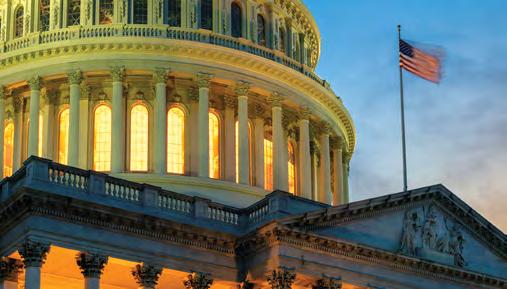



A NARFE PUBLICATION FOR FEDERAL EMPLOYEES AND RETIREES April 2024 VOLUME 100 ★ NUMBER 3 P. 26 Best Places to Retire 2024 P. 36 CSRS vs. FERS: Which Came Out on Top? P. 42 State Tax Treatment of Federal Annuities



brookdale.com A great movefor NARFE members Experience a senior living lifestyle that features restaurant-style dining, housekeeping, laundry and more with special savings for NARFE members. 1058444 SR monthly fee/basic service rate* 7.5 OFF SENIOR LIVING: % OFF 10 service rate** % IN-HOME SERVICES: DISCOUNTED RATES VARY BY COMMUNITY*** SHORT-TERM STAY: For more information, call (866) 787-9775 or visit brookdale.com/NARFE. ©2024 Brookdale Senior Living Inc. All rights reserved. BROOKDALE SENIOR LIVING is a registered trademark of Brookdale Senior Living Inc. *Discount is only applicable to new residents of a Brookdale independent living, assisted living, or memory care community admitting under an executed residency agreement. Discount applies only to the monthly fee/basic service rate, excluding care costs and other fees and is calculated based on the initial monthly fee/basic service rate. **Discount is only applicable to new clients of personal assistance services by a Brookdale agency under an executed service agreement. ***Discount is only applicable to new residents of a Brookdale assisted living or memory care community admitting under an executed respite agreement. Discount applies to the daily rate. Applicable to all discounts: Residents under a Life Care Agreement are not eligible for the discounts. These discounts do not apply to any room, board or services which are paid for all or in part by any state or federally funded program. Discounts are available to members and their family members, including spouse, adult children, siblings, parents, grandparents, and corresponding in-law or step adult children, siblings, parents, and grandparents through current spouse. Subject to availability. Further restrictions may apply.













NARFE MAGAZINE www.NARFE.org 1 P. 26 Best Places to Retire 2024 P. 36 CSRS vs. FERS: Which Came Out on Top? P. 42 State Tax Treatment of Federal Annuities Contents APRIL 2024 PAGE 26 COVER STORY FEATURE PAGE 36 Special Feature 42 State Tax Treatments of Federal Annuities Washington Watch 8 The NARFE Halftime Report 10 Harnessing Digital Platforms for Grassroots Advocacy 11 Bill Introduced to Increase Federal Pay Rates in 2025 12 Submit Proposed Changes to NARFE’s Advocacy Positions for the 119th Congress 14 Bill Tracker Columns 4 From the President 24 Benefits Brief 48 Managing Money Departments 6 NARFE Online 20 Questions & Answers 21 Countdown to COLA 50 NARFE News 54 NARFE Perks 56 The Way We Worked ON THE COVER Illustration by TGD FOR FEDERAL EMPLOYEES April 2024 P. 26 Best Places to Retire 2024 P. 36 CSRS vs. FERS: Which Came Out on Top? P. 42 State Tax Treatment of Federal Annuities CSRS VS. FERS: WHICH CAME OUT ON TOP? We compare the Civil Service Retirement System and the Federal Employees Retirement System after nearly 40 years since the latter plan was introduced to federal workers. BEST PLACES TO RETIRE 2024 Where do you see yourself happiest in retirement? Our latest advice helps federal workers weigh all financial considerations when choosing the right location. Connect with us! Visit us online at www.narfe.org Like us on Facebook NARFE National Headquarters Follow us on Twitter @narfehq Follow us on LinkedIn NARFE
APRIL 2024
VOLUME 100 ★ NUMBER 3
EDITORIAL DIRECTOR
Jenn Rafael
CREATIVE SERVICES MANAGER
Beth Bedard
CONTENT MANAGER
Matt Sanderson
ADDITIONAL GRAPHIC DESIGN
TGD
EDITORIAL BOARD
William Shackelford, Kathryn E. Hensley, Johann De Castro
CONTACT US
NARFE Magazine
606 North Washington St. Alexandria, VA 22314-1914
Phone: 703-838-7760 Fax: 703-838-7781
Editorial: communications@narfe.org
Advertising Sales: Francine Garner advertising@narfe.org
NARFE FOR THE VISUALLY IMPAIRED
ON THE TELEPHONE: This publication can be heard on the telephone by persons who have trouble seeing or reading the print edition. For more information, contact the National Federation of the Blind NFBNEWSLINE® service at 866-504-7300 or go to www.nfbnewsline.org.
ON DIGITAL AUDIO: Issues of NARFE Magazine are also available in audio format through the National Library Service for the Blind and Physically Handicapped (NLS). For availability, call 202-727-2142 or your local NLS service provider.
The Association, since July 1970, has been classified by the IRS as a tax-exempt labor organization [not a union]; however, dues and gifts or contributions to the Association are not deductible as charitable contributions for income tax purposes.

NATIONAL OFFICERS WILLIAM SHACKELFORD President; natpres@narfe.org
KATHRYN E. HENSLEY Secretary/Treasurer; natsectreas@narfe.org
CHIEF OF STAFF
JOHANN DE CASTRO jdecastro@narfe.org
TO JOIN NARFE, RENEW YOUR MEMBERSHIP OR FIND A LOCAL CHAPTER:
CALL (TOLL-FREE) 800-456-8410 OR GO TO www.narfe.org
TO CHANGE YOUR ADDRESS, PHONE NUMBER OR EMAIL
LISTING:
CALL (TOLL-FREE) 800-456-8410 EMAIL memberrecords@narfe.org
OR GO TO www.narfe.org, log in and click on “My Account”
TO REACH A FEDERAL BENEFITS SPECIALIST: EMAIL fedbenefits@narfe.org
NARFE HEADQUARTERS
606 N. Washington St. Alexandria, VA 22314 703-838-7760
Hours of operation: Monday-Friday, 8 a.m.-5 p.m. ET
REGIONAL VICE PRESIDENTS
REGION I Jeff Anliker (Connecticut, Maine, Massachusetts, New Hampshire, New York, Rhode Island and Vermont)
Tel: 413-813-8136
Email: jeff.anliker@outlook.com
REGION II Larry Walton (Delaware, District of Columbia, Maryland, New Jersey and Pennsylvania)
Tel: 443-831-1791
Email: rvp2@narfe.org
REGION III Lynn Harper (Alabama, Florida, Georgia, Mississippi, South Carolina and Puerto Rico)
Tel: 478-951-3260
Email: lynn_harper@msn.com
REGION IV Robert L. Helfrich (Illinois, Indiana, Michigan, Ohio and Wisconsin)
Tel: 317-501-1700
Email: rlhelfrich@yahoo.com
REGION V Cindy Reneé Blythe (Iowa, Kansas, Minnesota, Missouri, Nebraska, North Dakota and South Dakota)
Tel: 785-256-1450
Email: mrsdocbusyb@yahoo.com
REGION VI Marshall L. Richards (Arkansas, Louisiana, Oklahoma, Republic of Panama and Texas)
Tel: 903-660-2784
Email: pappysdad@cobridge.tv
REGION VII Sharon Reese (Arizona, Colorado, New Mexico, Utah and Wyoming)
Tel: 575-649-6035
Email: rvp7@narfe.org
REGION VIII Robert H. Ruskamp (California, Hawaii, Nevada and Republic of Philippines)
Tel: 703-628-3234
Email: ruskampr@gmail.com
REGION IX Steven Roy (Alaska, Idaho, Montana, Oregon and Washington)
Tel: 425-344-3926
Email: stevenroy1@yahoo.com
REGION X Robert Allen (Kentucky, North Carolina, Tennessee, Virginia and West Virginia)
Tel: 757-404-3880
Email: rvp10@narfe.org
NARFE Magazine (ISSN 1948-4453) is published monthly except in February
reasonable precaution is taken. All submissions become the property of NARFE. Copyright © 2024, NARFE. Advertisements in the magazine are not endorsements of products and/or services by NARFE, unless officially stated in the ad. We shall accept advertising on the same basis as other reputable publications: that is, we shall not knowingly permit a dishonest advertisement to appear in NARFE Magazine, but at the same time we will not undertake to guarantee the reliability of our advertisers.
2 NARFE MAGAZINE APRIL 2024
and July by the National Active and Retired Federal Employees Association (NARFE), 606 N. Washington St., Alexandria, VA 22314. Periodicals postage paid at Alexandria, VA, and additional mailing offices. Members: Annual dues includes subscription. Nonmember subscription rate
Postmaster: Send address change to: NARFE Attn: Member Records, 606 N. Washington St., Alexandria, VA 22314. To ensure prompt delivery, members should also forward changes of address without delay. Because of the volume involved, NARFE cannot acknowledge nor be responsible for unsolicited pictures and manuscripts, although every
$48.



A health center with doors open
and with our arms even
At Falcons Landing, exceptional care doesn’t end with our healthcare. Sure, we’re recognized by U.S. News & World Report as a “Best Nursing Home for Short-Term Rehabilitation and Long-Term Care,” and yes, we offer state-ofthe-art, specialized Memory Care in a brand-new, standalone neighborhood. But look closer and you’ll also find a close-knit community of people who excel at caring. So while our healthcare is outstanding, the common bonds that unite us are what’s truly remarkable.
Get to know us better!
your personal tour today: 703-844-3186

FALCONSLANDING.ORG Assisted Living • Skilled Nursing • Short-Term Rehabilitation • Memory Care FALCONSLANDING. ORG INDEPENDENT SENIOR LIVING | POTOMAC FALLS, VA Falcons Landing is proud to be a non-profit Life Plan Community.
WIDE
Schedule
WIDER
Eligibility for Independent Living at Falcons Landing is open to any officer that has served, senior level federal employees GS14 and above, spouses or surviving spouses. If you are looking for short-term rehab, long-term care, assisted living or memory care, no military or government background is required.

NARFE’S MISSION STATEMENT
To support legislation and regulations beneficial to federal civilian employees and annuitants and potential annuitants under any federal civilian retirement system and to oppose those detrimental to their interests.
To promote the general welfare of federal civilian employees and annuitants and potential annuitants, to advise and assist them with respect to their rights under retirement, health and other employee and retiree benefits laws and regulations, and to represent their interests before appropriate authorities.
To cooperate with other organizations and associations in furtherance of these general objectives.
Major Changes Are Coming
Changing times demand that organizations transform or be taken over by events.
Most members know that NARFE chapters have struggled to remain viable historically. One primary reason has been, and continues to be, the loss of members due to membership non-renewal. Additionally, as NARFE membership ages, leadership becomes a larger problem. Leaders age out and are unwilling or incapable of continuing. This problem is compounded by the unwillingness of other members to assume a leadership role in the chapter. The leadership scenario also exists in many of our federations.
Resolving this problem would require a significant organizational change. The National Executive Board (NEB) has been discussing a merger/closure plan since 2018 with no decision. There’s been no plan in five years! During the 2020 election period, Bylaw Amendment B-2009 was approved by NARFE membership, allowing federation mergers. National Bylaws, Article VIII Federation, Section 1 enables the NEB to authorize a federation merger consisting of two or more states.
In June 2023, I requested that the Strategic Planning Team, comprised of the regional vice presidents from Regions I, V and VII, move forward and develop federation merger and closure procedures. At the meeting of the NEB in December 2023, the federation merger and closure procedures were reviewed and approved, and a handbook was developed. Region VII Vice President Sharon Reese was approved to continue merging the Arizona and New Mexico federations, which will remain a part of Region VII. The first Federation Executive Board meeting of the new Southwest Federation was held in February. The success of this federation merger will truly demonstrate that the future of NARFE is in our hands.
2024 STRATEGIC PLAN
NARFE will continue to face several challenges in the future. We must take a measured approach to reform. The 2024 Strategic Planning Team/Committee continues to develop the strategic plan that makes sense for today while positioning our organization to attract a new generation of NARFE members.
MARKETING AND RECRUITMENT INITIATIVE
The NEB has been asked to authorize headquarters staff, under the guidance of Chief of Staff Johann De Castro and Member Engagement Director Nora MacDonald, to spend time formulating next steps in a plan which will work toward mitigating the decline of NARFE’s membership while beginning a process of growth. NARFE staff will incorporate the recommendations made by the NARFE federation presidents from their joint meeting with the NEB in August 2023. This plan will emphasize recruiting, retention and reinstatement. Admittedly, the timeline for this initiative will seem slow, but this is because the process should be a thoughtful and deliberate approach. Fulfillment will require doing things differently, but it is necessary to ensure that NARFE remains viable through the addition of members and improved member services.
FEDCON24 REMINDER
Online registration is open for FEDCon24, our premier NARFE conference, at fedcon.narfe.org in St. Louis. I hope you strongly consider joining us! As always, I appreciate your support so we can move NARFE forward together. The future of NARFE is in our hands. Stay healthy and stay safe!
 WILLIAM SHACKELFORD NARFE NATIONAL PRESIDENT natpres@narfe.org
WILLIAM SHACKELFORD NARFE NATIONAL PRESIDENT natpres@narfe.org
4 NARFE MAGAZINE APRIL 2024
From the President
















*With purchase of a new Safe Step Walk-In Tub. Not applicable with any previous walk-in tub purchase. Offer available while supplies last. No cash value. Must present offer at time of purchase. Other restrictions may apply. CSLB 1082165 NSCB 0082999 0083445 13VH11096000 Call Today For More Information! 1-800-253-0137 Visit BuySafeStep.com Scan to learn more BEFORE AFTER North America’s #1 Selling Walk-In Tub Professionally installed in as little as one day Easy to Use Premium Quality, Style, & Innovation Professional Installation Included Lifetime Warranty Made in Tennessee Bubbles, Massage Jets, & More + FREE SHOWER PACKAGE For a limited time only. $1600 * OFF

SAVE MONEY WITH NARFE PERKS
WHETHER you are planning your next vacation or move, buying a gift or planning for retirement, members can save money on every day purchases with special discounts from our Affinity Partners. Visit www.narfe.org/perks or see p.54.
Visit NARFE’s Legislative Action Center
NARFE’s team of professional lobbyists continues to work tirelessly on behalf of the federal community.
The association offers members a robust Legislative
Action Center at www.narfe. org/advocacy/legislativeaction-center. It is an easy way to send letters to your members of Congress, search for your legislators, report your congressional meetings,

STAY INFORMED
Stay on the pulse of key federal news and benefits information by subscribing to NARFE Daily News Clips. This newsletter features informative breaking news and informative articles curated just for NARFE members.
and more to supercharge your advocacy efforts.
Jump into the thick of several active grassroots campaigns and help them gain momentum. Your advocacy advances retirement security protections for all feds.

TSP
TSP Update Online
Get the most recent monthly and annual Thrift Savings Plan returns (G, F, C, S, I and L) online www. narfe.org/tsp-funds.
TRACKING RETIREMENT CLAIMS
Find out how many retirement claims OPM Retirement Services receives and processes each month, with average processing times and total inventory, at www.opm.gov/retirement-center/ retirement-statistics/
TAKE CHARGE OF YOUR BENEFITS
The NARFE Federal Benefits Institute is a membersonly resource designed to help you take charge of your benefits and guarantee a secure future. Visit narfe.org/ federal-benefits-institute.
Enjoy ongoing access to webinars, benefits briefs and other free resources, like contacting our special benefits expert to help with specific questions.

6 NARFE MAGAZINE APRIL 2024
NARFE Online
Does your mobility scooter keep you from being mobile?
MEET ATTO SPORT: THE MOST PORTABLE MOBILITY SCOOTER
With ATTO SPORT, Nothing Comes Between You and Being There
“Is your mobility scooter so hard to use that you don’t feel mobile? Too heavy or too complicated to take on trips? Too uncomfortable to use all day? I was frustrated with mine and with feeling stuck at home.
That’s why I found out about ATTO SPORT. Just one call and the nice people brought one to my home for a FREE test drive. The other scooter companies wouldn’t do that for me.
Folding Scooter Ad
Now I love my ATTO SPORT! It’s sturdy, splits into 2 pieces so I can lift it into my car trunk, and even carry it onto an airplane.”
Your new ATTO SPORT scooter is unlike any other scooter available today. It’s built to travel, whether around town or around the world. Ergonomically designed for your comfort and convenience.
ATTO SPORT splits into 2 pieces in under a minute for easy transport. You can even take it on an airplane as a carry-on. The heaviest piece is only 37 lbs., making it easy to put in your trunk. It even folds into a trolley shape with wheels for those times you need to move it without riding it.
Your ATTO SPORT snaps back together in seconds and you’re ready to go. The padded leather seat is adjustable, as is the tiller, to customize your riding position for comfort. Shock-absorbing tires and an extended wheelbase smooth out your ride. With ATTO SPORT, you’re looking good and feeling good all day long!

ATTO SPORT is more than just a stylish ride. Their super-smart engineers built-in quality and safety from day one. It’s a performance superstar with a 12-mile range and a top speed of over 6 miles per hour. With a 300 lbs. maximum capacity, it’s built to last. Electronic stability control and automatic slowing on downward slopes and turns keeps you safer than ordinary scooters. It even has front and rear lights for night visibility.
Don’t let a bulky or cheaply made scooter keep you from experiencing life. Join the thousands of ATTO SPORT owners worldwide.



comfortable seat Splits into 2 lightweight parts for easy lifting Folds in 3 seconds, rolls like a trolley suitcase
CRUISES ROAD TRIPS FLIGHTS
legroom,
Locations: Irvine CA, Burbank CA, Sacramento CA, Palm Desert CA, Phoenix AZ, Coconut Creek FL, Richmond VA, Chicago IL, Hartford CT, Houston TX Call Now FREE OFFICE AND HOME DEMOS 1-850-990-0111 | foldingscooterstore.com/narfe UP TO PROMO CODE: NARFE24 VALID UNTIL APRIL 15TH , 2024 $500 OFF! ONSCOOTER&ACCESSORIES WITH YOURNEWATTOSPORTPURCHAS E ! CANNOTBECOMBINED WITH OTHEROFFERS

The NARFE Halftime Report: Legislative Accomplishments from the First Session of the 118th Congress
NARFE’s advocacy efforts—a combination of grassroots and grasstops advocacy, direct lobbying and political action—in the first half of the 118th Congress spurred progress on top priorities while pushing back on continued threats.
Below are the highlights of how we made an impact on policy issues under consideration in the nation’s capital:
PROTECTING EARNED FEDERAL BENEFITS
No cuts to federal benefits were included in the two-year budget deal that reduced spending caps and raised the debt ceiling brokered between congressional leaders and President Joe Biden and codified via the Fiscal Responsibility Act of 2023.
Unfortunately, some in Congress continue to propose policies that would cut earned federal benefits and seek to include them in larger budget deals. Such proposals include reducing or eliminating costof-living adjustments to federal annuities, decreasing the government share of health insurance premiums under
the Federal Employees Health Benefits (FEHB) program, reducing the initial retirement benefit for current federal employees approaching retirement, and/or reducing the rate of return on federal civilian and military retiree savings in the Thrift Savings Plan G Fund. NARFE continues to prioritize fighting back against such
proposals, as they would renege on promised benefits earned via public service.
PROGRESS INCREASING SUPPORT FOR WEP/GPO REPEAL AND REFORM
The Social Security Fairness Act, H.R. 82/S. 597, to repeal the Windfall Elimination Provision (WEP) and the Government Pension Offset (GPO) was reintroduced in both chambers of the 118th Congress with NARFE’s support.
At the end of 2023, H.R. 82 accrued 301 cosponsors, significantly higher than at the same time in the 117th Congress
APRIL ACTION ALERT: SUPPORT MARKUP OF THE SOCIAL SECURITY FAIRNESS ACT, H.R. 82
Visit NARFE’s Legislative Action Center at www.narfe.org to send a message to your lawmakers requesting they push the House Ways and Means Committee to advance the Social Security Fairness Act, H.R. 82, with a favorable recommendation, to the floor! With more than 300 cosponsors, this bill is closer to achieving legislative progress in repealing the Windfall Elimination Provision (WEP) and Government Pension Offset (GPO)−two longstanding provisions that unfairly reduce the retirement benefits of hardworking public servants.
8 NARFE MAGAZINE APRIL 2024 Washington Watch
Washington Watch
(when the bill ended 2021 with 242 cosponsors), and S. 597 accrued 49 cosponsors, also higher than at the same time in the 117th Congress (when the bill ended 2021 with 37 cosponsors).
In another sign of progress, the House Committee on Ways and Means also held a hearing on WEP and GPO on November 20, 2023, in Baton Rouge, LA, highlighting the impact of WEP/ GPO on everyday Americans.
Momentum continues to build within Congress to address these issues, whether via full repeal or incremental reform, such as via H.R. 4260, the Public Servants Protection and Fairness Act, or H.R. 5342, the Equal Treatment of Public Servants Act, the reintroduction of which NARFE also supported.
IMPROVING CUSTOMER SERVICE PROVIDED BY THE OFFICE OF PERSONNEL MANAGEMENT’S (OPM) RETIREMENT SERVICES (RS) DIVISION
NARFE’s advocacy has helped highlight concerns within Congress and the administration regarding significant retirement processing delays and the inability of annuitants and their families to connect with OPM to receive needed assistance. NARFE-drafted language has been included in House Financial Services and General Government appropriations committee reports requiring OPM to publicize various retirement claims and benefits change processing times and
MYTH VS. REALITY
MYTH: A committee “markup” is simply about approving bills as introduced.
REALITY: Committee markup is a significant phase in which committee members debate, amend and rewrite proposed legislation. This process can alter the original bill, affecting its impact if it becomes law. Markup sessions provide an opportunity for detailed scrutiny and refinement of legislation.
call center response rates, along with quarterly congressional briefings on the issues. Senate appropriators have directed increased funding for OPM to improve OPM’s customer service.
NARFE continues to push for the modernization of processes and information technology, adequate funding for OPM, and continued congressional oversight. While the situation has improved recently, with the inventory of new retirement claims decreasing from 25,227 in October 2022 to 14,292 in December 2023, this may result from lower annual claims rather than increased monthly claims processing.
SUPPORTING CHOICE FOR FEDERAL HEALTH BENEFITS
As OPM began to encourage FEHB plans to provide Medicare Prescription Drug plans, NARFE continued to push for choice for federal retirees—to opt out (or in) to such plans, based on the individual’s circumstances. A hallmark of the FEHB program, NARFE will continue to push for individual choice to enable federal employees, retirees, and their survivors to select the best plan that meets their individual needs.
OPPOSITION TO GOVERNMENT SHUTDOWNS
While issues arising from extensive government funding debates are often out of NARFE’s control, NARFE continues to press lawmakers to avoid unnecessary and wasteful government shutdowns. This
comes most often from providing supporting arguments and information to allied lawmakers (and staff) and supporting centrist efforts to find common ground with the opposing party.
PROGRESS BUILDING SUPPORT FOR FULL COLAS FOR FERS RETIREES
NARFE supported the reintroduction of the Equal COLA Act, H.R. 866/ S. 3194, to provide Federal Employees Retirement System (FERS) annuitants with an annual COLA equal to the relevant CPI increase via passage of the. Current law holds the FERS COLA at 2% if the full COLA falls between 2% and 3%, and it reduces FERS COLAs by one percentage point if the full COLA exceeds 3%. The Equal COLA Act would eliminate these reductions, providing a full COLA.
At the end of 2023, H.R. 866 accrued 46 cosponsors, more than the total accrued at the end of the 117th Congress (when the bill had 34 cosponsors).
PROTECTING A MERITBASED CIVIL SERVICE
The merit-based civil service framework provides continuity of government through changing administrations, preserves institutional knowledge and expertise, and safeguards the rule of law and adherence to the Constitution. NARFE has opposed attempts to eliminate the merit-based system (via legislation) or to bypass it using
NARFE MAGAZINE www.NARFE.org 9
SEE HALFTIME REPORT ON P. 12

NARFE GRASSROOTS ADVOCACY
LEARN MORE about how you can take action to protect your earned pay and benefits by reviewing NARFE Grassroots materials at www.narfe.org/advocacy.
Harnessing Digital Platforms for Grassroots Advocacy: The Power of Social Media
In the realm of grassroots advocacy, embracing the digital world has become a strategic advantage and necessity. The rise of platforms like Facebook, X, formerly known as Twitter, LinkedIn, and other social media channels, has revolutionized how advocates engage with policymakers and the public. While traditional methods like letters, emails, and phone calls still hold value, the digital landscape offers a dynamic and immediate way to amplify messages and engage directly with lawmakers and a broader audience.
THE GROWING IMPORTANCE OF SOCIAL MEDIA IN ADVOCACY
Statistics show an increasing number of lawmakers are active on platforms like X. A report by the Pew Research Center reveals that every serving legislator (541 in total across both houses of Congress) has at least one X account. This offers a unique opportunity for advocates to engage with them directly. The immediacy and public nature of platforms like X make them powerful tools for advocacy. With a single tweet, advocates can reach their representatives and a wider audience, rallying support and raising awareness on critical issues.
X, FORMERLY KNOWN AS TWITTER: A KEY PLAYER IN MODERN ADVOCACY
X, often misunderstood as just a platform for short updates, is a potent advocacy tool. Its short-form blogging style allows for concise, impactful dialogue and messaging that can quickly capture attention. Retweeting and sharing posts help disseminate information rapidly, expanding the reach and influence of an advocacy campaign. Moreover, hashtags on X can link conversations and issues, creating a cohesive online movement that is easily trackable and joinable.
For instance, a study by the Congressional Management Foundation found that it takes only 30 tweets about an issue for Congressional staffers to take notice. This statistic underscores the efficacy of social media over traditional methods like letter writing or email, primarily due to the public visibility and direct engagement it offers.
SOCIAL MEDIA: AMPLIFYING ADVOCACY MESSAGES
One of social media’s greatest strengths in grassroots advocacy is its ability to amplify messages. By leveraging these platforms, advocates can spread their message far and wide, engage with a larger community, and build a network of supporters. Social media campaigns can quickly go viral, bringing unprecedented
attention to issues that might otherwise remain unnoticed in the corridors of power.
ENGAGEMENT BEYOND X
While tweeting is effective, engagement doesn’t stop there. Social media advocates can monitor their representatives’ activities and stances, participate in relevant online discussions, and organize virtual events like X “town halls” or Facebook Live discussions. This level of engagement creates a twoway communication channel between fellow advocates and policymakers, fostering a more interactive and responsive form of engagement.
EMBRACING THE DIGITAL SHIFT
The digital world has opened new grassroots advocacy avenues, making it more dynamic, immediate, and far-reaching. Platforms like X are not just tools for communication; they are instruments of change in the hands of skilled advocates. As the digital landscape continues to evolve, so must our strategies for NARFE advocacy. By embracing these platforms and learning to use them effectively, members can keep up with the changing times and lead the charge in shaping policies that concern our federal community.
—BY IVANA SARA, GRASSROOTS PROGRAM MANAGER
10 NARFE MAGAZINE APRIL 2024 Washington Watch
Washington Watch
Bill Introduced to Increase Federal Pay Rates in 2025
Rep. Gerry Connolly, D-VA, and Sen. Brian Schatz, D-HI, introduced their annual version of the Federal Adjustment of Income Rates (FAIR) Act on January 26, which would provide a 2025 pay raise to federal workers.
This year’s FAIR Act, H.R. 7127/S. 3688, would provide a 7.4% average federal pay raise for 2025 by introducing a 4.0% across-the-board increase and a 3.4% average increase in locality pay rates. The proposed pay increase is crafted to ensure federal pay rates keep up with inflation and bridge the gap between federal and private sector pay, strengthening the recruitment and retention of our nation’s civil service.
The Federal Salary Council reported that federal employees made 27.54% less salary and wage than their private sector counterparts in 2023. In 2022, the council reported a wage gap of 24.09%. This represents a percentage point increase and a trend of the growing gap in real wages between the two sectors.
In support of the bill, NARFE National President William “Bill” Shackelford stated, “Congressman Connolly and Senator Schatz propose a strong federal pay raise via the FAIR Act to counter a resilient labor market, steadily increasing private-sector pay, continued price increases, and the persistent gap between private-sector and federal
NARFE

q
q
q
q
q
q
pay for similar jobs. We’re grateful for their support for hardworking public servants and ensuring federal pay rates approach levels needed to recruit and retain an effective federal workforce.”
Thanks to an executive order signed by President Joe Biden, federal employees will see an average pay increase of 5.2% in 2024. While this represents the largest single increase in year-to-year federal pay since the Carter administration, the passage of the FAIR Act would help make the federal workforce more competitive with the private sector and give employees a much-deserved raise.
—BY KHAMARE GARNER, POLITICAL ASSOCIATE
To comply with federal law, we must use our best efforts to obtain, maintain and submit the name, mailing address, occupation and name of employer of individuals whose contributions exceed $200 each calendar year. NARFE-PAC is for the benefit of political candidates and activities on a national level. NARFE members have the right to refuse to contribute without reprisal, and NARFE will neither favor nor disadvantage anyone based on the amount of a contribution or failure to make a voluntary contribution. The suggested amounts are only suggestions and not enforceable. Only members of NARFE may contribute to the PAC. Contributions from non-members will be returned. NARFE-PAC contributions are not
NARFE MAGAZINE www.NARFE.org 11
Monthly contributors of $10 or more receive a sustainer lapel pin
deductible
q Charge my credit card q MasterCard q VISA q Discover q AMEX Card #: Exp. Date: _____ /_________ mm yyyy Name on Card: Signature: Date: Mail coupon and/or check payable to NARFE-PAC to: NARFE-PAC Budget & Finance | 606 North Washington St. | Alexandria, VA 22314
for federal income tax purposes.
Member #:
City:
ZIP: Occupation: Employer: CONTRIBUTE TO Make a one-time contribution:
Name: Address:
State:
$25
Basic lapel pin
–
$50
Bronze lapel pin
–
$100
Silver lapel pin
–
$250
Gold lapel pin
–
$500 – Platinum lapel pin
Other: _________ n No pin for me. I’d like 100 percent of my contribution to go to NARFE-PAC. OR Contribute monthly through your annuity or by credit card. Get started at narfe.org/pac-sustainer Contribution totals are cumulative for the 2023-2024 election cycle

LEGISLATIVE RESOURCES
NARFE NewsLine – A weekly newsletter that goes out to NARFE members on Tuesdays and includes weekly recaps of legislative news, compiled by NARFE’s advocacy and communications teams.
LEGISLATIVE ACTION CENTER – A one-stop site to send a letter to Congress, and more, at www.narfe.org.
Submit Proposed Changes to NARFE’s Advocacy Positions for the 119th Congress
While we’re still working with the current Congress, NARFE must also be ready for the next one. To do so, NARFE must adopt Advocacy Positions for the 119th Congress, which convenes on January 3, 2025. NARFE’s Advocacy Positions detail NARFE’s specific policy stances, and they direct and guide NARFE’s leadership and staff regarding whether to support a position—or not—when actions are taken by Congress or the Administration.
An advocacy Committee, appointed by NARFE’s National President, will consider proposed changes to NARFE’s Advocacy Positions, and recommend a final product
for adoption by the National Executive Board.
If you’d like the Advocacy Committee to consider a certain proposal, you or your chapter may submit proposals via webform at https://www.narfe. org/narfes-advocacy-positionssubmission-form-for-the-119thcongress-2024/, or you may mail in a hard copy form. You may request a hard copy form for your chapter or as an individual by calling NARFE’s advocacy department at 1-800-4568410, option 3, or via e-mail at advocacy@narfe.org
Proposals submitted by chapters must certify the chapter supported the proposal via a majority of those voting and present. You may also
certify endorsement from your federation, if the proposal receives support via a vote of the majority of those voting and present at a federation board meeting. These proposals will be posted on an Advocacy Positions thread in the Open Forum on FEDHub for comment.
Proposals submitted by individuals will also be posted on the Advocacy Positions thread. In lieu of chapter support, they must receive 5 recommendations from other NARFE members to receive consideration by the Advocacy Committee.
The deadline for submissions is June 1.
—BY NARFE ADVOCACY STAFF
a statutory loophole such as Schedule F. Schedule F was a new excepted service schedule that exploited statutory loopholes to create a broad new exception to merit-based civil service rules. It was created at the tail end of the Trump Administration but was not fully implemented before the change in administrations (and its revocation).
NARFE has worked with congressional allies to develop legislation prohibiting Schedule F’s return and supporting its reintroduction via the Saving the Civil Service Act,
H.R. 1002/S.399 in the 118th Congress to protect the meritbased system. NARFE has also supported attempts to include this legislation in the National Defense Authorization Act via amendments.
Additionally, NARFE has supported through formal comments the Office of Personnel Management’s proposed rule titled “Upholding Civil Service Protections and Merit System Principles,” which will provide new procedural protections to prevent – or at least delay – a future attempt to implement Schedule F (or a similar policy),
and by successfully opposing a House floor amendment to defund implementation of the proposed rule (which failed by a vote of 198-221).
SECURING A PAY RAISE FOR FEDERAL EMPLOYEES IN 2024
NARFE supported the presidential alternative pay plan to increase federal employee pay by 5.2% on average in 2024, at parity with the military and tracking recent private sector pay increases.
—BY JOHN HATTON, STAFF VICE PRESIDENT, POLICY AND PROGRAMS
12 NARFE MAGAZINE APRIL 2024 Washington Watch
HALFTIME REPORT FROM P.9










•


•





•





































10/29/08 11:21:34 AM National Active and Retired Federal Employees Association CONGRESSIONAL DIRECTORY 118th Congress 2023-2024 NARFE’s CONGRESSIONAL DIRECTORY FOR THE 118 th CONGRESS (2023-2024) Features:
Members of Congress by state delegation, with color photos, biographical data and congressional district maps.
Members’ contact information, including addresses, phone and fax numbers, website addresses, social media contacts, district offices and key staffers.
Complete listings of committees, subcommittees and leadership.
Contact information for the White House, Cabinet, Supreme Court and federal agencies. Be a stronger advocate with NARFE’s Congressional Directory at your fingertips Order online at www.narfe.org/directory Order your copy of the new CONGRESSIONAL DIRECTORY today! Name Address City State ZIP Member ID# (as it appears on NARFE Magazine label) o Check (payable to NARFE) o Charge my credit card o MasterCard o VISA o Discover o AMEX Card # Exp. Date / (mm) (yy) Name on card (print) Signature Date Please allow 3-4 weeks for delivery. Call NARFE’s Advocacy Department at 800-456-8410, option 3, to order by phone. Quantity $25 each (includes shipping and handling) VA sales tax VA residents add 6% tax ($1.50) per book Total cost Only $25 Mail to: NARFE Congressional Directory 606 N. Washington Street Alexandria, VA 22314-1914
•
NARFE BILL TRACKER
THE NARFE BILL TRACKER IS YOUR MONTHLY GUIDE TO LEGISLATION NARFE IS FOLLOWING. CHECK BACK EACH ISSUE FOR UPDATES.
WHAT BILL WOULD DO
LATEST ACTION(S)
H.R.159/S.59: Chance to Compete Act of 2023 / Rep. Virginia Foxx, R-NC / Sen. Kyrsten Sinema, I-AZ
Cosponsors:
H.R. 159: 3 (D) 2 (R) S. 59: 1 (D) 2 (R) 0 (I)
H.R. 1002/S. 399: Saving the Civil Service Act / Rep. Gerry Connolly, D-VA / Sen. Tim Kaine, D-VA
Cosponsors:
H.R. 1002: 18 (D) 3 (R) S. 399: 16 (D) 0 (R) 1 (I)
Implements merit-based reforms to the civil service hiring system that replace degree-based hiring with skills- and competency-based hiring.
Prevents any position in the federal competitive service, created after September 30, 2020, from being reclassified into the excepted service, outside the protection of merit system rules without the express consent of Congress. The bill also requires the consent of an employee to be reclassified, mandates reporting of conversions to the Office of Personnel Management, and places caps on the number of employees converted to the excepted service via Schedule C.
FEDERAL PERSONNEL POLICY
H.R. 1487: The Strengthening the Office of Personnel Management Reform Act / Rep. Gerry Connolly, D-VA
Cosponsors: H.R. 1487: 1 (D) 0 (R)
Codifies several recommendations for OPM by the National Academy of Public Administration (NAPA), such as clarifying that OPM stands at the center of federal civilian human resource management and ensuring the director of OPM possesses human capital and leadership expertise.
Passed the House under suspension of the rules 1/24/2023
Referred to the Senate Committee on Homeland Security and Governmental Affairs 1/24/2023
Referred to the House Committee on Oversight and Accountability 2/15/2023
Referred to the Senate Committee on Homeland Security and Governmental Affairs 2/14/2023
Referred to the House Committee on Oversight and Accountability 3/9/2023
H.R. 3115/S. 1496: Public Service Reform Act / Rep. Chip Roy, R-TX / Sen. Rick Scott, R-FL
Cosponsors:
H.R. 3115: 0 (D) 15 (R)
S. 1496: 0 (D) 1 (R) 0 (I)
Would make all federal employees at-will and enable workers to be removed for good cause, bad cause or no cause at all. The legislation would also abolish the Merit System Protections Board and limit removal appeals to claims of whistleblower retaliation and Equal Employment Opportunity Commission complaints before the US Court of Appeals.
Referred to the House Committee on Oversight and Accountability 5/5/2023
Referred to the Senate Committee on Homeland Security and Governmental Affairs 5/9/2023
14 NARFE MAGAZINE APRIL 2024 NARFE’s Position: Support Oppose No position
NUMBER / NAME / SPONSOR
ISSUE BILL
NARFE BILL TRACKER
THE NARFE BILL TRACKER IS YOUR MONTHLY GUIDE TO LEGISLATION NARFE IS FOLLOWING. CHECK BACK EACH ISSUE FOR UPDATES.
H.R. 82/S. 597: The Social Security Fairness Act / Rep. Garret Graves, R-LA / Sen. Sherrod Brown, D-OH
Cosponsors:
H.R. 82: 203 (D) 105 (R) S. 597: 40 (D) 7 (R) 3 (I)
H.R. 4260: The Public Servants Protection and Fairness Act / Rep. Richard Neal, D-MA
Cosponsors:
H.R. 4260: 102 (D) 0 (R)
SOCIAL SECURITY
H.R. 4583/S. 2280: Social Security 2100 Act / Rep. John Larson, D-CT / Sen. Richard Blumenthal, D-CT
Cosponsors:
H.R. 4583: 182 (D) 0 (R) S. 2280: 4 (D) 0 (R) 0 (I)
H.R. 5342: Equal Treatment of Public Servants Act of 2023 / Rep. Jodey Arrington, R-TX
Cosponsors: 1 (D) 27 (R)
Repeals both the Government Pension Offset (GPO) and the Windfall Elimination Provision (WEP).
The House Committee on Ways and Means held Field Hearing on 11/21/2023
Referred to the Senate Committee on Finance 3/1/2023
FEDERAL ANNUITIES
H.R. 716: The Fair COLA for Seniors Act / Rep. John Garamendi, D-CA
Cosponsors:
H.R. 716: 37 (D) 0 (R)
H.R. 866 / S. 3194: The Equal COLA Act / Rep. Gerry Connolly, D-VA / Sen. Alex Padilla, D-CA
Cosponsors:
H.R. 866: 43 (D) 3 (R) S. 3194: 6 (D) 0 (R) 1 (I)
Reforms the Windfall Elimination Provision (WEP) by providing a monthly rebate of $150 to current beneficiaries (age 62 or older before 2025) and creating a new formula to calculate benefits for future WEP-affected individuals (turning 62 in or after 2025).
Expands and strengthens Social Security benefits, improves solvency of the Social Security trust funds, repeals the Windfall Elimination Provisions and Government Pension Offset, and provides numerous other Social Security related improvements.
Reforms the WEP by providing a monthly payment of $100 to current WEP-affected beneficiaries and $50 for an affected spouse or child. Creates a new formula to calculate benefits for future WEP-affected individuals (turning 62 in or after 2025).
Requires Social Security and federal retirement programs to use the Consumer Price Index for the Elderly (CPI-E) to calculate cost-of-living adjustments (COLAs) to retirement benefits.
Provides Federal Employees Retirement System (FERS) retirees with the same annual cost-of-living adjustment (COLA) as Civil Serve Retirement System (CSRS) retirees.
Referred to the House Committee on Ways and Means 6/21/2023
Referred to the House Committees on Ways and Means, Education and the Workforce, and Energy and Commerce 7/12/2023
Referred to the Senate Committee on Finance 7/12/2023
Referred to the House Committee on Ways and Means 9/5/2023
Referred to the House Committees on Ways and Means, Veterans’ Affairs, Oversight and Accountability, and Armed Services 2/1/2023
Referred to the House Committee on Oversight and Accountability 2/8/2023
NARFE MAGAZINE www.NARFE.org 15 NARFE’s Position: Support Oppose No position
ISSUE
WHAT BILL WOULD DO LATEST ACTION(S)
BILL NUMBER / NAME / SPONSOR
NARFE BILL TRACKER
THE NARFE BILL TRACKER IS YOUR MONTHLY GUIDE TO LEGISLATION NARFE IS FOLLOWING. CHECK BACK EACH ISSUE FOR UPDATES.
H.R. 536/ S. 124: The Federal Adjustment of Income Rates (FAIR) Act / Rep. Gerry Connolly, D-VA / Sen. Brian Schatz, D-HI
Cosponsors:
H.R. 536: 77 (D) 1 (R)
S. 124: 19 (D) 0 (R) 1 (I)
H.R. 856/ S. 274:
Comprehensive Paid Leave for Federal Employees Act / Rep. Don Beyer, D-VA / Sen Brian Schatz, D-HI
Cosponsors:
H.R. 856: 36 (D) 3 (R)
S.274: 10 (D) 0 (R) 1 (I)
H.R. 1301/ S. 640: Federal Employees Civil Relief Act / Rep. Derek Kilmer, D-WA / Sen. Brian Schatz, D-HI
Cosponsors:
H.R. 1301: 3 (D) 0 (R)
S. 640 15 (D) 0 (R) 1 (I)
FEDERAL COMPENSATION
H.R. 5883 / S. 3029:
Honoring Civil Servants Killed in the Line of Duty Act of 2023 / Rep. Gerald Connolly, D-VA / Sen. Kyrsten Sinema, I-AZ
Cosponsors:
H.R. 5883: 1 (D) 2 (R)
S. 3029: 1 (D) 2 (R) 0 (I)
H.R. 5995: The Federal Retirement Fairness Act / Rep. Derek Kilmer (D-WA)
Cosponsors:
H.R. 5995: 53 (D) 21 (R)
Provides federal employees with an 8.7% average pay raise in 2024.
Referred to the House Committee on Oversight and Accountability 1/26/2023
Referred to the Senate Committee on Homeland Security and Governmental Affairs 1/26/2023
Extends paid leave to federal and postal employees for all conditions covered by the Family and Medical Leave Act (FMLA).
Referred to the House Committee on Oversight and Accountability, Veteran’s Affairs and House Administration 2/7/2023
Referred to the Senate Committee on Homeland Security and Governmental Affairs 2/7/2023
Protects federal workers and contractors from a variety of civil financial penalties during a lapse in appropriations or a breach of the debt ceiling.
H.R. 7127: Federal Adjustment of Income Rates (FAIR) Act / Rep. Gerry Connolly (D-VA) / Sen. Brian Schatz (D-HI )
Cosponsors: 61 (D) 0 (R)
Aims to significantly increase death gratuities and funeral allowances for federal employees who tragically lose their lives while serving the nation. This bill would ensure that the families of dedicated civil servants receive greater financial support during their time of loss.
Allow federal employees who started their careers as temporary workers, but transitioned to permanent work, to buy credit towards retirement for their temporary work. The FRFA enables these workers to make catch-up contributions, ensuring they receive full retirement credit for their service.
Provides federal employees with a 7.4% average pay raise in 2025
Referred to the House Committees on Oversight and Accountability, Financial Services, Ways and Means, Judiciary, Education and Workforce, and House Administration 3/1/2023
Referred to the Senate Committee on Finance 3/2/2023
Referred to Committee on Homeland Security & Government Affairs 10/4/23
Referred to House Committee on Oversight and Accountability 10/25/23
Introduced in House 1/30/24
16 NARFE MAGAZINE APRIL 2024
NUMBER / NAME / SPONSOR WHAT BILL WOULD DO LATEST ACTION(S)
ISSUE BILL
NARFE’s Position: Support Oppose No position
Donate
Donate to NARFE
MAKE CHECK PAYABLE TO:
NARFE
PLEASE MAIL COUPON AND CHECK TO:
NARFE / 606 N. Washington St. / Alexandria, VA 22314 or donate online at www.narfe.org/ donate
With NARFE’s thanks, you will receive a NARFE Photo Calendar
NARFE safeguards the earned pay and benefits of America’s five million federal workers, retirees, their spouses, and survivors. NARFE is YOUR legislative voice and tireless advocate. NARFE contributions are NOT tax-deductible.
to NARFE programs
Enclosed is my NARFE Contribution: $ __________________
All donations go to the NARFE General Fund to support NARFE Programs and operations.
Name:
Address:
City:
State: ZIP:
Credit Card Information: q M/C q VISA q Discover q AMEX
Card Number:
Expiration Date: (mm)/ (yy) Security Code:
Signature:
Name: (please print)
Support Alzheimer’s Research
Date: / /
NARFE members contributed for Alzheimer’s research: $16 Million Fund $16,139,625.31*
*Total as of January 2024 All contributions go directly to Alzheimer’s research, with the exception of funds given to the Walk to End Alzheimer’s or The Longest Day.
If you have any questions, write to:
National Committee Chair
Olivia Williams
PO Box 2175 Columbia, SC 29202
OR E MAIL: oeashf3@gmail.com
MAKE CHECK PAYABLE TO:
NARFE-Alzheimer’s Research (w rite your chapter number on memo line)
PLEASE MAIL COUPON AND CHECK TO:
Alzheimer’s A ssociation
225 N. Michigan Ave., 17th Floor Chicago, I L 60 601-7633
Your charitable contribution is tax-deductible to the fullest extent allowed by law.
Give to the NARFE-FEEA Fund
MAKE CHECK PAYABLE TO:
NARFE-FEEA Fund
PLEASE MAIL COUPON AND CHECK TO:
FEEA
1641 Prince St. Alexandria, VA 22314
Your charitable contribution is tax-deductible to the fullest extent allowed by law.
Enclosed is my NARFE-Alzheimer’s contribution: $
Every cent that is contributed is used for research.
Name:
Address:
City:
State: ZIP:
Chapter number:
Credit Card Information: q M/C q VISA q Discover q AMEX
Card Number:
Expiration Date: (mm)/ (yy) Security Code:
Signature:
Name: (please print)
Date: / /
The NARFE-FEEA Fund supports NARFE members during disasters; provides scholarships to their children, grandchildren and great-grandchildren; and funds other programs to support NARFE members at the direction of NARFE and FEEA.
Enclosed is my NARFE-FEEA Fund Contribution: $ ________
Name:
Address:
City:
State: ZIP:
Email:
To make credit card or e-check contributions, visit www.feea.org/givenarfe.

1 The Service Benefit Plan may pay a hearing aid benefit for Basic and Standard Option members up to $2,500 total every 5 calendar years for adults age 22 and over, and up to $2,500 total per calendar year for members up to age 22. FEP Blue Focus does not have a hearing aid benefit. Do not rely on this communication piece alone for complete benefit information. All benefits are subject to the definitions, limitations, and exclusions in the Blue Cross and Blue Shield Service Benefit Plan brochure. The Blue365® Discount Program offers access to savings on items that you may purchase directly from independent vendors, which may be different from items covered under the Service Benefit Plan or any other applicable federal healthcare program. For hearing aids, acupuncture, chiropractic and vision services, you must exhaust your Service Benefit Plan benefit first before accessing the savings of the Blue365® Discount Program. To find out what is covered under your policy, contact the customer service number on the back of your member ID card. The products and services described herein are neither offered nor guaranteed under any local Blue company’s contract with the Medicare program. These items are not subject to the Medicare appeal process. Any disputes regarding these products and services are not subject to the Disputed Claims process. Blue Cross Blue Shield Association (BCBSA) may receive payments from Blue365 vendors. Neither the Service Benefit Plan, nor any local Blue company recommends, endorses, warrants or guarantees any specific Blue365 vendor or item. The Service Benefit Plan reserves the right to change, modify, or terminate any item and vendors made available through Blue365, at any time. 2 Price shown does not include cost of comprehensive hearing exam. Examination and testing for prescribing of hearing aids is covered under the Service Benefit Plan. The member should confirm that the provider rendering the hearing exam is a Preferred provider. If the provider is Non-preferred, the member Dedicated Hearing Consultant 3-year manufacturer warranty 1 year of follow-up visits 80 free batteries per non-rechargeable hearing aid Risk-free 60-day trial period TruHearing purchases include: Your allowance goes further with TruHearing®. TruHearing offers discounted pricing on the latest hearing aids with all styles and models from the leading manufacturers. Rechargeable | Listed products are smartphone-compatible 3 Prices and products subject to change. Sample product Average retail price TruHearing price Allowance (up to $2,500)1 ou pay2 TruHearing Advanced $5,440 $2,500 $2,500 $0 Widex Moment® Sheer™ 220 $4,536 $2,500 $2,500 $0 Signia® 3IX $4,588 $2,700 $2,500 $200 Oticon® Real™ 3 $5,116 $2,900 $2,500 $400 Starkey Evolv® AI 1600 $5,460 $3,100 $2,500 $600 ReSound OMNIA™ 7 $5,844 $3,390 $2,500 $890 Phonak® Audéo® Lumity® L-R 90 $7,590 $4,500 $2,500 $2,000 You pay2 Example savings (per pair) Cynthia is wearing the TruHearing Premium RIC hearing aid Find this and other great deals on fepblue.org/blue365




may be charged a maximum fee of $75 for the exam, and the member may need to submit a claim for reimbursement. Must be a Service Benefit Plan member to access TruHearing discounted pricing. TruHearing is offered through Blue365, which provides exclusive health and wellness deals and is a program of Blue Cross Blue Shield Association, an association of independent Blue Cross and Blue Shield companies. The Blue Cross® and Blue Shield® words and symbols, Federal Employee Program®, FEP® and Blue365® are all trademarks owned by Blue Cross Blue Shield Association. 3 Smartphone compatible hearing aids connect directly to Android, iPhone®, iPad®, and iPod® Touch devices. Connectivity also available to many Android® phones with use of an accessory. All content ©2023 TruHearing, Inc. All Rights Reserved. TruHearing® is a registered trademark of TruHearing, Inc. All other trademarks, product names, and company names are the property of their respective owners. Listed retail prices based on a survey of national average retail hearing aid prices compared to average TruHearing pricing. Savings may vary. Retail pricing of TruHearing-branded aids based on prices for comparable aids. Follow-up provider visits included for one year following hearing aid purchase. Free battery offer is not applicable to the purchase of rechargeable hearing aid models. Three-year warranty includes repairs and one-time loss and damage replacement. Hearing aid repairs and replacements are subject to provider and manufacturer fees. For questions regarding fees, contact a TruHearing Hearing Consultant. FEP_NARFE_AD_453254 TruHearing is an independent company that provides discounts on hearing aids. Great hearing aids are just the start. Great hearing aids are just the start. In addition to lowered pricing on high-quality hearing aids, Blue Cross and Blue Shield Service Benefit Plan members also get a full hearing care package and unmatched service when they use their allowance through TruHearing. Call TruHearing to get started saving today. 1-877-360-2432 | For TTY, dial 711 Made available through:

Q&A
EMPLOYMENT
HIGH-3 AVERAGE SALARY
QIf I take a lower paying job, will that reduce my high-3 average salary since I will be making less income at the end of my federal career?
AIf you take a lower-paying job, your high-three average salary will not go down, but it may not go up either. Your high-three average salary is based on the average of your highest three consecutive years of basic salary rates. Although it is often the final three years of employment, this does not have to be the case if the “highest” three-year average falls before the end of the career. This may happen when a federal employee transfers to an area where the locality pay is lower than their previous assignment or if there is a temporary promotion or an employee takes a lower salary rate. Since locality pay is included in the definition of basic pay, a change in locality rate can impact the high-three average. Once you are retired, however, your retirement benefit amount will not be affected by the location of where you live.
MILITARY LEAVE
QI used military leave to serve as a reservist for two weeks on active duty. Do I need to pay a deposit for this service period to receive credit towards my retirement?
ATHE FOLLOWING QUESTIONS & ANSWERS were compiled by NARFE’s Federal Benefits Institute experts. NARFE does not provide legal, financial planning or tax advice or assistance.
If you were receiving federal civilian pay while on military leave, the appropriate deductions for your retirement should have been withheld, so there is no need to pay a military deposit for these brief periods. This period of covered service should count towards your retirement service computation date (SCD). In most cases, federal employees simultaneously serving in military reserves have enough military leave each year to cover their annual training periods with their reserve units. Keep in mind that if you remain on active duty after exhausting your allotment of paid military leave, then your agency will typically place you on leave without pay for uniformed service (LWOP-US) status, and upon returning to pay status, you would have the option to pay a military deposit to your civil retirement system for the period of LWOP-US. Otherwise, the period of LWOP-US would not count toward your retirement SCD.
A fact sheet on military leave is available at
https://www.opm.gov/policy-data-oversight/ pay-leave/leave-administration/. The Office of Personnel Management’s (OPM) Retirement Support Center has a series of frequently asked questions, including ones regarding military service and leave https://www.opm.gov/support/ retirement/ and https://www.opm.gov/policydata-oversight/pay-leave/pay-administration/ fact-sheets/military-leave/
20 NARFE MAGAZINE APRIL 2024
Questions & Answers
FEGLI OPTION C—FAMILY COVERAGE
QI am a current federal employee. I got married 11 months ago and missed the 60-day “qualified life event” window to elect family coverage (Option C) under the Federal Employees Group Life Insurance (FEGLI) program. I currently have basic coverage under FEGLI, but can I use Standard Form 2822 to make this election if my spouse is healthy, or do I have to wait for a FEGLI open season to make this election?
AUnfortunately, Standard Form 2822 only allows you to add FEGLI Options A and/or B (or to re-enroll in Basic FEGLI). It does not allow you to add Option C (family coverage). If OPM offers another FEGLI open season while employed, you could use this opportunity to add Option C at that time. Also, while federally employed, if you experience a qualified life event (QLE) such as the adoption or birth of a child, you could elect to add Option C to your FEGLI within 60 days of any such QLE. These QLEs are listed in the instructions accompanying Standard Form 2817. You can find forms at https://www.opm.gov/forms.
If your spouse is healthy and otherwise insurable, a term life insurance policy may be an alternative to FEGLI. Worldwide Assurance for Employees of Public Agencies (WAEPA) provides two options for spouses of current and former federal employees: dependent coverage or an associate membership. Becoming an associate member is an option for you and your spouse if you seek higher coverage amounts and more benefits than dependent coverage. Learn more at https://www.waepa.org/products/associatemembership/ or call (800) 368-3484.
NON-DEDUCTION SERVICE
QI’m currently a FERS employee, and I started my federal career in the late 1990s with a temporary appointment before I was converted to FERS retirement coverage. Will I receive retirement service credit for this temporary service?
AUnfortunately, non-deduction service (federal civilian employment not covered by FERS retirement deductions) is not creditable for retirement eligibility or the computation of your FERS retirement benefit. FERS employees may pay a deposit for federal civilian service not covered by retirement deductions only if performed before January 1, 1989. There are exceptions for volunteers
with the Peace Corps and VISTA. The NARFE Federal Benefits Institute presented a webinar titled “Understanding Military and Civilian Federal Service Credit,” you can watch the recorded version of this webinar at www.narfe.org. NARFE believes all federal work should be credited toward retirement calculations. Ask your representative to cosponsor the Federal Retirement Fairness Act, H.R. 5995, introduced in 2023, allowing federal employees to credit their temporary service performed after 1988 into their retirement calculations.
RETIREMENT
SOCIAL SECURITY REDUCTION
QI’m a federal employee retiring at age 62, and I receive around $2,000 a month in Social Security and $3,000 a month in federal annuity payments. I may also withdraw $50,000 annually from the Thrift Savings Plan (TSP) regular pot (not Roth). I worked after retirement and earned $30,000 at a retail job for the year. In this scenario, here are my two questions:
1. Is it correct that the employee exceeded the income threshold for social security and would have to pay back $7,680 ($30,000-$22,320) to
COUNTDOWN TO COLA
The Consumer Price Index for Urban Wage Earners and Clerical Workers (CPI-W) increased 0.49 percent in January 2024. To calculate the 2025 cost-of-living adjustment (COLA), the 2024 third-quarter indices will be averaged and compared with the 2023 third-quarter average of 301.236. The percentage increase determines the COLA. January’s index, 302.201, is up 0.32 percent from the base.
The CPI represents purchases of food and beverages, housing, apparel, transportation, medical care, recreation, education and communication, and other goods and services.
For FECA COLA updates, visit narfe.org and search for FECA.
NARFE MAGAZINE www.NARFE.org 21
MONTH CPI-W Monthly % Change % Change from 301.236 OCTOBER 2023 302.071 -0.06 0.27 NOVEMBER 301.224 -0.28 -0.0004 DECEMBER 300.728 -0.16 -0.17 JANUARY 2024 302.201 0.49 0.32 FEBRUARY
the Social Security Administration (SSA)?
2. Would an employee’s annuity payments and TSP withdrawals be considered ‘earned income’ for the Social Security income test?
AThe answer to your second question is that your annuity and TSP withdrawals will not be counted as earnings for the Social Security earnings test. When Social Security figures out how much to deduct from your benefits due to your retail job earnings, they count only the wages you make from your job or your net earnings if you’re selfemployed. They will include bonuses, commissions, and vacation pay. They will not count pensions, annuities, investment income, interest, veterans’ benefits, or other government or military retirement benefits. Your lump sum annual leave payment will not count against the limit because it was considered a “special payment” earned before you retire. Your benefits may increase when you work after you retire because you will continue to pay Social Security taxes on your earnings. Social Security will check your record every year to see whether your additional earnings will increase your monthly benefit. You will receive a letter about your new benefit amount if there is an increase.
You are correct in assuming that the work you plan to do following your retirement will be counted against the earnings limit because you will be retiring well under the full retirement age. For those individuals who retire mid-year, you may already have earned more than the annual earnings limit ($22,230 for 2024) by the time you retire, so that’s why there is a special monthly rule that applies to earnings for one year, usually the first year of retirement. Under this rule, you can get a full Social Security check for any month you retire, regardless of your yearly earnings. In 2024, a person younger than full retirement age for the entire year is considered retired if monthly earnings are $1,860 or less.
In your example, if the $30,000 you earn in your retail job is earned after your retirement date, it would be counted for the earnings test. The reduction is $1 for every $2 over the limit. If you retire on June 30, 2024, and you earn $30,000 from July through December, or $5,000 per month, which is $3,140 over the 2024 monthly earnings limit, your Social Security benefit would be reduced by $1,570 per month ($3,140 divided by 2) leaving you with a reduced Social Security benefit amount of $1,430.
You may want to consider delaying your Social Security application for a while to see if you will continue to work since your income will reduce your Social Security benefit. At age 62, your Social Security benefit payments are 30% less than if you waited until age 67 (your full retirement age) to apply. For individuals born in 1960 or later, the full retirement age is 67, and the reduction for applying early is computed at 5/9 of 1% per month for the first 36 months and 5/12 of 1% for each additional month. The following pamphlet on http://www.ssa.gov is titled “How Work Affects Your Benefit (2024).”
One additional tip: be careful about the amount of your TSP withdrawals, so you don’t deplete your TSP balance too soon in your retirement. Remember that at age 62, you may have several decades left to live.
REDUCING FEGLI COVERAGE
QWhen I retired from federal service years ago, I elected to keep FEGLI coverage with the “75% reduction” elected for my basic coverage. I elected to keep five multiples of my final salary with the “no reduction” option elected for Option B coverage. When I recently turned 65, I noticed that the cost associated with my basic coverage became premiumfree, but I’m still paying for my Option B coverage. I recently lost my spouse, and I’d like to cancel my Option B coverage. Can I do this?
AP lease accept our condolences for the recent loss of your spouse. At age 65, the cost per $1,000 of FEGLI Option B increases from $.953 to $1.17, which is almost a 25% increase in the price of this coverage. If you don’t reduce this coverage, it will continue to increase in premium cost at age 70 (to $2.080/$1,000 per month), age 75 (to $3.90/$1,000 per month), and finally at age 80 and over (to $5.72/$1,000 per month). Fortunately, you can change Option B of FEGLI after you have retired. These changes include the following: .
1. If you are under age 65, you, but not your assignee, can change from full reduction to no reduction.
2. You and your assignee (if you have “assigned” your life insurance) may change from no reduction to full reduction if you are under age 65.
3. You and your assignee (if you have “assigned” your life insurance) may change from no reduction to full reduction if you are 65 or older. In addition to changes that can be made after retirement, certain restrictions include:
22 NARFE MAGAZINE APRIL 2024 Questions & Answers
4. You cannot change from full reduction to no reduction if you are 65 or older.
5. If you have assigned your life insurance, your assignee cannot change from full reduction to no reduction if they are under age 65.
Suppose you change from “no reduction” to “full reduction” for Option B rather than cancel the coverage, and it has been less than 50 months since you turned 65. In that case, this election will allow you to retain a reduced amount of coverage until the coverage ends at noon on the day before the 50th reduction would occur. After that, no benefits are payable upon your death (for option B). Although this election will eventually eliminate your Option B coverage, you will continue to have 25% of your basic coverage payable as a death benefit regardless of how long you live, as you elected the 75% reduction for Basic FEGLI when you retired.
Once you have retired, OPM’s Retirement Operations Center (ROC) becomes your “agency employing office.” All records relating to your FEGLI are kept in that office, and any questions or actions you want to take regarding your FEGLI coverage must be directed to that office. This is true for all retired civilian employees, regardless of which retirement system they retire under. If you need to contact the ROC, the phone number is
1-88-US-OPM-RET (1-888-767-6738) outside the Washington, D.C., metropolitan area or 202-6060500 within the Washington area. Annuitants should send written inquiries to the Retirement Operations Center, P.O. Box 45, Boyers, PA 16017-0045. Annuitants may also contact OPM by email at retire@opm.gov or visit the OPM websites for Retirement (www.opm.gov/retire) or FEGLI (www.opm.gov/healthcare-insurance/ life-insurance).
MEDICARE PART B PREMIUMS
QIs the Income-Related Monthly Adjustment Amount (IRMAA) that applies to Medicare B premiums recalculated annually based on the latest tax returns filed? .
AThe Medicare Part B premium you are charged is based upon your Modified Adjusted Gross Income (MAGI) from two years prior, generally the most recent tax return information that Social Security has received from the IRS. For example, 2024 Medicare Part B premiums will be based on your MAGI from 2022. Suppose your Part B premium is subject to an IRMAA, and you have experienced a life-changing event that caused your income to go down, such
as work reduction or stoppage, divorce, death of a spouse, etc. In that case, you can use the SSA-44 form to request a drop to your premium. For more details, including the list of qualifying lifechanging events, please refer to the most recent version of this form, which is usually updated at the end of December each year, https://www.ssa. gov/forms/ssa-44.pdf.
CSRS OFFSET
QI retired as a Civil Service Retirement System Offset employee when I was 58. When should I expect OPM to apply the offset and reduce my annuity?
AOPM will contact the SSA to obtain an entitlement determination when you are close to age 62 (the average age of Social Security eligibility) or during OPM’s retirement adjudication process if you are over 62 when you retire. If you can receive Social Security benefits (you have worked and paid Social Security taxes for 10 years or more), SSA will provide OPM with information concerning your Social Security benefits.
Please note that even if you do not apply for Social Security benefits when first eligible, the reduction in your annuity must still be made if you are entitled or would, on proper application, be entitled to Social Security benefits. We have heard from a few CSRS Offset retirees who were not notified of the reduction to their CSRS retirements at age 62. Notifying OPM if you are CSRS Offset and your annuity was not reduced at age 62 is essential. This can result in an overpayment that must be repaid when discovered. The offset reduction is subtracted from the annuity rate to become your new gross annuity rate. The offset reduction is the lesser of:
• The difference between the Social Security monthly benefit amount with and without Federal earnings or
• The product of the Social Security monthly benefit amount, with federal earnings, multiplied by a fraction where the numerator (top of fraction) is the employee’s total CSRS Offset service, rounded to the nearest whole number of years and the denominator (bottom of fraction) is 40.
To obtain an answer to a federal benefits question, NARFE members should call 800-456-8410 and select option 2 for the Federal Benefits Institute; send the question by postal mail to NARFE Headquarters, ATTN: Federal Benefits; or submit it by email to fedbenefits@narfe.org.
NARFE MAGAZINE www.NARFE.org 23

SBENEFITS RESOURCES
NARFE OFFERS MEMBERS a wide range of information on federal benefits. Visit www.narfe.org/federal-benefits-institute.
Delaying Medicare Enrollment
ometimes, procrastination pays off. Consider enrollment in Medicare. The 2024 standard rate for Medicare Part B is $174.70. For beneficiaries who file an individual tax return with modified adjusted gross income over $103,000 in 2022 or a couple filing a joint return with income over $206,000, the premium is even higher due to the Income Related Monthly Adjustment Amounts (IRMAA) surcharges.
Parts A and B enrollment, known as original Medicare, typically occurs during the initial enrollment period (IEP). This begins three months before your 65th birthday and ends three months after your birthday. This seven-month period allows your coverage to begin the month you turn 65 or the month after you enroll if you delay enrollment past your birthday. Although most federal employees and retirees sign up for Part A during their IEP, for Part B, the feds have additional options to delay enrollment to save the cost of adding Part B:
• Special Enrollment Period (SEP): Use the SEP that lasts up to eight months following the end of “current employment” health coverage. The SEP allows federal employees covered by the Federal Employees Health Benefits Program (FEHB) through their current employment to delay enrollment and avoid the Part B late enrollment penalty. This also applies to the spouse of a current employee who has turned 65 but is under the FEHB enrollment of the still-employed spouse. See
Social Security Administration (SSA) Publication 05-10012, “How to Apply for Medicare Part B (Medical Insurance) During Your Special Enrollment Period.”
• General Enrollment Period (GEP): Use the GEP in any year from January 1 through March 31 with coverage effective the following month. If less than 12 months have elapsed since the end of the IEP, there would be no late enrollment penalty, so the cost of Part B coverage can be delayed. This would also apply if an individual worked past age 65 and used the GEP that followed the end of the SEP if less than 12 months had elapsed from the month the employment ended until the coverage began.
• Enroll in Part A only and delay Part B enrollment: Approximately 20% to 25% of federal retirees choose to enroll in Part A only at age 65, and some never enroll in Medicare Part B. Under the FEHB law, the plan must limit payments for inpatient hospital and physician care to those payments you would be entitled to if you had Medicare. Your physician and hospital must follow Medicare rules and cannot bill you for more than they could if you had Medicare. You and the FEHB benefit from these payment limits. See the chart in your FEHB plan brochure for more information about the limits. Let’s look at a couple of examples to see how this would play out:
Example 1: Roman is retiring on June 30, 2024, at age 69 and will be eligible to continue his FEHB coverage for himself and his wife, Anna. They are both enrolled in Medicare Part A only. Roman and Anna will have a SEP from July 2024 until February 2025 (eight months following his retirement) to enroll in Medicare Part B without a late enrollment penalty. He could also delay his enrollment until March 2025, the last month of the GEP, and not be assessed a penalty since less than 12 months have elapsed from when his employment ends in June until his coverage would begin in April 2025.
By delaying enrollment to April 2025, the couple saved $3,144.60 ($174.70 x 9 x 2).
Example 2: Penny retired in 2015 at age 56 and continued FEHB coverage. She will turn 65 in June 2024. Her IEP will last through September. She may decide to delay her enrollment until the end of the 2025 GEP to delay the premium and continue to avoid a late enrollment penalty. While Penny is enjoying good health, she is saving $2,094.40 (2024 rate) for every 12 months that she does not pay the Part B premium, and she has decided to delay her enrollment until the 2027 GEP.
Although she will incur a 20% late enrollment penalty (two 12-month periods during the 30 months between the end of her IEP and the date her coverage took effect), she saved over $5,000. Her penalty would be $174.70 x 20% = $34.94/month. Penny doesn’t mind paying the penalty since it would take almost 12 years before she would have paid as much penalty as she had saved by not enrolling.
24 NARFE MAGAZINE APRIL 2024 Benefits Brief
There are advantages to enrolling in Medicare Part B despite the additional premium that must be paid. Consider the following benefits:
• Many FEHB plans waive their cost-sharing (deductible, copays, coinsurance) when Medicare is the primary payer. When suffering from multiple chronic conditions, this can save thousands of dollars in out-of-pocket medical expenses.
• Enrollment in Medicare might add additional benefits that would not otherwise be available. For example, BC/BS Basic provides enhanced prescription drug coverage that includes access to mail-order prescriptions for members enrolled in Medicare.
• Some FEHB plans provide a health fund or Medicare Part B reimbursement to help lower the cost of enrolling in Medicare Part B.
• Many FEHB plans offer a Medicare Advantage option for Medicare A and B members. This coverage provides additional Part B rebates and benefits such as free gym membership, meal delivery following a hospital stay, and non-emergency transportation to doctor visits.
• For military retirees, TRICARE for Life requires Medicare A and B enrollment.
• Starting in 2025, the Postal Service Health Benefits (PSHB) Program will require Medicare Part A and
B enrollment. If you are an annuitant as of January 1, 2025, and did not enroll in Part B, you will not be required to enroll. However, if you are already enrolled, you are required to remain enrolled. Suppose you were an annuitant entitled to Medicare Part A before January 1, 2024, and did not enroll in Medicare Part B. In that case, you and your covered, eligible family members may be able to participate in the SEP for Medicare Part B that started April 1, 2024. Those who enroll during the SEP will not need to pay the late enrollment penalty.
There is no guarantee your current health plan or health will remain the same in the future.
Remember that you may have decades of life to live past age 65. Some retirees in their seventies told me they regretted not applying when their FEHB plan stopped participating or they moved out of the service area, and they needed to select a new plan with higher cost-sharing than the plan they had before.
While there are people with high healthcare spending at all ages, overall, people aged 55 and over accounted for 55% of total health spending in 2021 despite making up only 31% of the population. In contrast, people under age 35 comprised 44% of the population but were responsible for only 21% of health spending.







NARFE MAGAZINE www.NARFE.org 25 AN ACORN STAIRLIFT IS THE PERFECT SOLUTION FOR: *Not valid on previous purchases. Not valid with any other o ers or discounts. Not valid on refurbished models. Only valid towards purchase of a NEW Acorn Stairlift directly from the manufacturer. $250 discount will be applied to new orders. Please mention this ad when calling. AZ ROC 278722, CA 942619, MN LC670698, OK 50110, OR CCB 198506, RI 88, WA ACORNSI894OB, WV WV049654, MA HIC169936, NJ 13VH07752300, PA PA101967, CT ELV 0425003-R5, AK 134057. HIC.0656293 CALL NOW AND SAVE! SPECIAL OFFER $250 OFF CALL TODAY & RECEIVE TOWARD THE PURCHASE OF AN ACORN STAIRLIFT!* Plus receive your FREE stairlift buying guide, info kit & DVD! Arthritis/COPD su erers Those with mobility issues Anyone who hurts using the stairs
—MICHELE BOLLIER IS A RETIREMENT AND BENEFITS SPECIALIST WITH RETIRE FEDERAL.
BEST PLACES TO RETIRE 2024
BY EVERETT A. CHASEN
Whether to move in retirement, and where to go, is a difficult choice. Here are some tips to help in your decision process.


26 NARFE MAGAZINE APRIL 2024




NARFE MAGAZINE www.NARFE.org 27
One of the most significant decisions federal employees nearing retirement and those recently retired face is whether to remain where they live and work or to move somewhere else. Factors like proximity to family, cost of living, the availability of health care facilities and overall lifestyle preferences all play into deciding whether to stay or go, and many find it one of the most challenging choices they’ve ever made.
Tools are available to make this decision easier, like NARFE’s State Tax Treatment of Federal Annuities (found on page 42), which can help you pick a place to live that will reduce your overall tax burden. But tax rates are not the only factor most people should consider, says Thiago Glieger, a private wealth adviser for RMG Advisors (www.thefedcorner.com). This full-service firm helps federal employees and their families with retirement planning needs.
“The biggest thing we help federal employees think about is where they see themselves happy in retirement,” Glieger said. “If you can start with a blank canvas and paint a picture, would you live in a concrete jungle? Would it be a beach? Would you want to live on a lake?”
If you spend most of your time at the location where you work and are not thrilled to be there, you’ll be miserable.
“I don’t care how much money you have,” he adds. “Money is not going to solve that problem.”
Financial Considerations
Glieger believes financial independence is a “super important” factor but not the only issue to consider in choosing a retirement location.
“There is a tax consequence to virtually every financial decision you make in retirement,” he says. “Anything you can do to keep more of what you’ve earned will put you in a better position and create a better lifestyle.”
“One of the hardest things people struggle with in thinking about retirement is how to turn a

giant pile of money or retirement paychecks into a lifetime of income,” Glieger continues.
Those who live in any metropolitan area will find their cost of living is higher than those who move to places like Montana.
“There are a lot of one-time retirement expenses that need to be accounted for in a plan,” he said. “If you’ve built them in, whether the stock market is up, down, or sideways, it doesn’t matter. You’ll still have the financial freedom to do what’s important to you.”
“Can you afford to live in New York City when you retire?” he asks. “Because you’re increasing your expenses when you only have a finite pile of money to work with.”
Do research online before considering a move.
Glieger asked, “What are the costs of real estate? Can you afford to live in that area? What do rent costs look like?”
Many of RMG’s clients consider places like Florida, Alaska, Nevada, South Dakota,
28 NARFE MAGAZINE APRIL 2024




Tennessee, Texas and Wyoming — seven states that do not levy income taxes. According to Glieger, they leave places like Virginia, Maryland and the District of Columbia because they don’t want to pay 6% or 7% state income tax. (Note, however, that many of the states with no income tax make up lost revenue with other types of taxes, like a sales tax, or by providing reduced services to residents.)
Moving to a location without a state income tax means “now you don’t owe an additional 7% on however much money you take out each month from your Thrift Savings Plan (TSP), Individual Retirement Arrangements or your pension or wherever you get money. And that’s significant.”
“When you’re living on a fixed income, it’s challenging,” Glieger said. “Every dollar matters. Tax evasion is illegal—but tax avoidance is smart.”
He suggests if you are moving somewhere you’ve never lived before, rent for at least one year.
“There is a tax consequence to virtually every financial decision you make in retirement.” - Thiago Glieger, private wealth adviser for
RMG Advisors
“Because if you jump and make a purchase immediately, closing costs come with buying a house,” he said. “And if you change your mind about a place two or three years after buying a property, you’re probably not going to recover those closing costs.”
Rocket Mortgage, an online mortgage, credit card and personal finance company (rocketmortgage.com), estimates closing costs are approximately 3% to 6% of the loan amount. “This means that if you take out a mortgage worth
NARFE MAGAZINE www.NARFE.org 29


average closing costs by state. Among the lowest are Arkansas, Indiana, Kentucky, and West Virginia; those with the highest costs include California, Hawaii, New York, and the District of Columbia.


tax, but also because of the weather.
“Sunshine does a whole lot of good for the heart and soul, especially for people who have seasonal affective disorder,” he said. Also known as SAD, it is a mood disorder characterized by depression that’s related to changes in seasons.
Florida is also famous because a lot of other retirees live there.
Finding a place to rent for a year or so gives you a sense of whether or not you want to relocate there permanently.
“You get to have a sense of ‘Hey, I really like this neighborhood,’” Glieger said. “I like the people here, the culture, the weather, the time when the sun rises in the morning, all the different components of life. Before you make a more permanent decision like actually buying a home and moving everything, see if you can see yourself living in the place long term.”
The cost of renting is money you won’t ever get back, but Glieger considers it an insurance policy.
“It helps you avoid making a bad decision you’ll regret later, which will cost you a lot more money,” he said.
Choosing Where To Go
Many of Glieger’s clients move to Florida when they retire, not only because there is no state income
“There is something to be said about having a feeling of belonging with the community around you—like-minded people,” Glieger said. “Continuing to feel like you’re a part of something is critical for people’s mental health and satisfaction in retirement.”
Most federal employees are part of an incredible mission: serving our nation. He adds that if they retire without continuing to contribute to their community or to others, they can feel like the rug had been pulled out from under them.
“That can be traumatic mentally for people,” Glieger said.
That’s why Glieger believes senior living communities for ages 55-plus tend to be popular. He asks, “As life moves on, where are your friends and colleagues who are also retiring? Can you meet up with them as often as you’d like? And if you have kids and grandchildren, are you traveling to meet up with them?”
30 NARFE MAGAZINE APRIL 2024
“There is something to be said about having a feeling of belonging with the community around you— people that are like-minded.
Continuing to feel like you’re a part of something is critical for people’s mental health and satisfaction in retirement.” - Thiago Glieger, RMG Advisors
According to Glieger, it’s most important to gauge if you feel like you are still part of a community when you’re no longer contributing to your organization’s mission.
Glieger cites the lifestyle of a client who now lives on a Professional Golfers’ Association golf course in Florida.
“His golfing is his passion in life, and he absolutely loves the people he’s met,” he said.
Another client is relocating to the Annapolis, MD, area, because he and his wife want to become part of the extensive sailing community there.
Florida, where nearly 40% of all hurricanes that made landfall in the United States since 1851 have hit, is not perfect for everyone.
“Can you get insurance on your house? Find out before you buy,” Glieger said. “If your house is not insurable because it has an extremely high natural disaster risk, that’s going to impact your retirement plan for sure. Because you may not have enough capital to cover a catastrophic loss like, for example, a flooded basement.”
Since 2003, the state with the most disaster declarations (including wildfires, severe storms like tornadoes, and hurricanes) has been California, according to moneygeek.com. Second is Texas, followed by Oklahoma, Washington, and Oregon. Florida, although it has many more hurricanes than other states, ranks eighth on this list because it has fewer wildfires than the western states—but it also has had the highest amount of property damage from storms and hurricanes, followed by four eastern states: Louisiana, New Jersey, New York and North Carolina.
In July 2023, FEDWeek listed 11 states they called “retirement hot spots” for federal retirees. Florida was first on their list because of its great weather, lower housing costs, no state income tax and no tax on pensions.
Second was Georgia, with no tax on Social Security income or inheritance or estate tax, plus great weather and beautiful scenery. Third was Texas, which has no state income tax and a wide variety of areas to choose from. Then came Wyoming, also with no state income tax, and no tax on pensions, 401(k), or on TSP withdrawals, plus “seemingly endless hiking trails” and two national parks. Fifth was North Carolina, with beautiful scenery and tax breaks for seniors, allowing retirees to be exempted from state taxes up to $35,000 of their retirement income once they reach 65.
Other states on FEDWeek’s preferred list include Alaska, South Dakota, Tennessee, Pennsylvania, Nevada and Washington.
Health Care, Airport Proximity, Political Ideologies And More
Glieger suggests considering health care as a significant factor.
“Is there a doctor whose help has been lifechanging for you?” he asks. “And if you’re going to be moving away from this person, is there someone in the area, or a clinic in the area, that your doctor recommends?”
This is especially critical if you have an unusual medical condition and need a medical facility with expertise in treating that condition.
“How far are you from an airport?” Glieger asks. “Will you have to take a dune buggy to get to one?”
These are questions that are more tactical than financial, he says, Political leanings are another consideration that can affect happiness for retirees.
“Everyone in the D.C. area is politically opinionated, and if you move to a place where everyone’s politically opinionated in the other direction, that might make you feel a little bit out of place,” Glieger said. “Unfortunately, it’s the reality, and it should be considered.”
And finally, there’s the question of grandchildren, an important one for many retirees.
“There is something different about having grandchildren, right?” Glieger asks. “They move your heart in a totally different way. If you’re close to your family, and that’s super important
NARFE MAGAZINE www.NARFE.org 31



An alternative solution to moving near your children and grandchildren, whether you stay where you are or move to a new location, is to dedicate funds in your retirement plan that will enable you to visit your family often.

lifetime, and it’s also essential to create your own life and not be dependent on your child or grandchild to be happy. If you move, are you interested in working part-time, volunteering to help others, or getting involved with an organization or religious institution to make new friends?
Glieger suggests an alternative solution to moving near your children and grandchildren, whether you stay where you are or move to a new location, is to dedicate funds in your retirement plan that allows you to visit your family often.
to you, then it needs to be a consideration in your retirement planning.”
Some adult children don’t really want their parents moving closer to them, although the prospect of additional help is often welcome in this era of two-career families. Also, your child’s career may require them to move, and you may have to go through the stressful process of picking up stakes and making new friends more than once. And how do you choose if you have grandchildren living in different cities? Will your other children feel you are picking a favorite or saddling one child with the burden of taking care of you when you no longer can care for yourself?
It’s not easy to leave a place you are familiar with and friends you’ve made over the course of a
“We want to include seeing the grandkids in the blank canvas we are painting,” he said. “So, part of the painting and the canvas will incorporate maybe two or three trips a year to go visit them, which comes with a price tag. What does that price tag look like? And once you factor in that price tag, how are you going to account for it? Is there a specific kind of account in which you want to have that traveling account, and how should you be investing that regularly, so it is continuing to grow and sustain future travel for you as well.” Turn to page 42 to read NARFE’s State Tax Treatment of Federal Annuities.
—EVERETT A. (EV) CHASEN IS A WRITER AND COMMUNICATIONS CONSULTANT IN THE WASHINGTON, D.C., AREA. HE RETIRED FROM THE FEDERAL GOVERNMENT AFTER 35 YEARS OF SERVICE.
32 NARFE MAGAZINE APRIL 2024

Active and Retired Federal Employees–Join NARFE (or Renew) Today!
The only organization dedicated solely to protecting and preserving the benefits of all federal workers and retirees, NARFE informs you of any developments and proposals that affect your compensation, retirement and health benefits, AND provides clear answers to your questions.
Who Should Join NARFE?
If your future security is tied to federal retirement benefits—federal retirees, current employees, spouses and individual survivors—you should join NARFE. Membership expiring? Renew now!
NARFE MEMBER BENEFITS
• Understand benefit changes and key aspects to stay on top of with NARFE’s monthly webinars, held on a variety of topics such as TSP’s, health insurance options and long term care insurance updates
• Direct access to Federal Benefits Institute experts who can answer your most pressing questions and help you get answers you need from OPM
• Topical and robust articles on new legislation, and topics like car buying tips and finding your path in retirement, and the ever popular Q&A section addressing your most burning benefit questions in NARFE Magazine
• Support from your peers with access to FEDHub, the only national online community for the federal community, and local chapters, where you can meet feds in a neighborhood near you
• Weekly news roundup email called Newsline, with helpful tips and updates from NARFE on the work we are doing to support you
• Discounts on popular national brands with NARFE Perks
• Powerful advocacy and alerts to take action on important legislation pending in Congress and our advocacy team that protects your benefits every day!
NARFE MEMBERSHIP APPLICATION
o Yes. I want to join NARFE for the low annual dues of $48
o Mr. o Mrs. o Miss o Ms.
Full Name
o Renew my membership
Street Address Apt./Unit
City State ZIP
Phone
Email
Retirement date (or expected)
Membership ID if renewing (ID # can be found on cover of magazine)
I am a (check all that apply)
o Active Federal Employee o Active Federal Employee Spouse o Annuitant o Annuitant Spouse o Survivor Annuitant
o Please enroll my spouse
Spouse’s Full Name
Spouse’s Email
THREE EASY WAYS TO JOIN/RENEW
1. Complete this application and mail with your payment to NARFE Member Services / 606 N Washington St / Alexandria, VA 22314-1914.
2 Join online at www.NARFE.org
3. Call 800-456-8410 , Monday through Friday, 8 a.m. to 5 p.m. ET.
PAYMENT OPTIONS
o Check or Money Order (Payable to NARFE)
o Charge my:
o MasterCard o VISA o Discover o AMEX
Card No.
Expiration Date _______/_______ (MM/YY)
Name on Card
Signature Date
TOTAL DUES
$48 annual dues x ________=_________ per person #enrolling total dues
Dues payments are not deductible as charitable contributions for federal income tax purposes.
LOOKING TO MEET OTHERS in the federal community? Go to www.narfe.org/chapters to find a chapter near you.
Are you a new member who wants to receive a FREE one-year chapter membership? Choose one:
o Chapter closest to home OR o Chapter #____________
Renewing members can call 800-456-8410 x1 to inquire about your chapter dues amount or to join a NARFE chapter today.
THANK YOUR RECRUITER Did someone introduce you to NARFE? Please provide their name and member ID.
Recruiter’s Name
Recruiter’s Membership ID
NARFE respects the privacy of our members. Personal information is used to provide content and relevant communications to our members. Some NARFE member benefits are provided by third parties (NARFE Perks), and not NARFE. (02/24)
NARFE MAGAZINE www.NARFE.org 33
1Q6
AUGUST 18-20
HYATT REGENCY ST. LOUIS AT THE ARCH
THE EFFORT TO ADVANCE NARFE’S MISSION STARTS WITH YOU. JOIN US for FEDcon24, NARFE’s biennial national training conference. Gain the knowledge necessary to LEARN how to make the most of your benefits, ADVOCATE to protect those earned benefits, and LEAD the organization that defends them into the future.
LEARN. ADVOCATE. LEAD
Register today at fedcon.narfe.org to take advantage of the early bird discount.
REGISTER TODAY at fedcon.narfe.org



Book your hotel by July 19 in order to take advantage of NARFE’s special group rate of $130 per night.




NARFE’S BIENNIAL NATIONAL CONFERENCE
FEDCON24 SPEAKERS

MARK KEEN
Financial planner helping feds plan for retirement

TAMMY FLANAGAN
Federal benefits and retirement expert
Visit fedcon.narfe.org to see confirmed speakers.
FEDCON24 BREAKOUT SESSION PREVIEW
Attendees will choose from at least six options during each breakout session timeslot, with session tracks for Advocacy, Current/Active Federal Employee, Federal Benefits, NARFE Leadership, and Lifestyle. Examples of sessions within featured tracks are listed below:
ADVOCACY TRACK
Advocacy Update: What’s the Latest and What’s Ahead
Evolving Advocacy: NARFE’s Grassroots Toolbox for Today and Tomorrow
Leading NARFE-PAC in 2024 and Beyond
NARFE LEADERSHIP TRACK
Membership Recruitment


Leadership Succession Planning
Chapter Officer 101
Best Practices for Chapter/Federation Communication
Utilizing the AMS as a Chapter/Federation Officer
FEDERAL BENEFITS TRACK
Don’t Fall for These Common Retirement Myths
Getting Your Affairs in Order: Estate Planning for Feds
Maximizing the After-Tax Value of Retirement Savings Medicare & FEHB/PSHB
MORE SPEAKERS TO COME!


36 NARFE MAGAZINE APRIL 2024


From COLAs to annuities to survivor benefits, here’s how the two federal retirement systems stack up
BY DAVID TOBENKIN
NARFE MAGAZINE www.NARFE.org 37
IThe Federal Employees
Retirement System (FERS) was unveiled to new workers almost 40 years ago, aiming to replace the Civil Service Retirement System (CSRS). When comparing today’s two systems, only a small fraction of active employees are enrolled in CSRS.
Millions of federal retirees have used both systems to enjoy decades of retirement benefits. With all this data now available, is it possible to determine whether the same annuitant under FERS or CSRS would come out ahead? We’re taking a look.
The Two Systems: FERS and CSRS
CSRS is the older of the two plans. It was designed before Social Security was implemented to provide a fair retirement wage through a full pension. After Social Security reform in 1983 and new federal employees joined the retirement plan, FERS was designed to offer a strong combined benefits package. This included Social Security benefits while reducing the size of the annuity,
“I’ve moved clients into FERS and I’ve moved them into CSRS. It was really dependent upon their situation and what they did to make that determination.”
— Micah Shilanski, CFP
while adding an employer match for participation in the new Thrift Savings Plan (TSP), a tax-deferred 401(k)-type defined contribution retirement savings and investment program.
“When we modeled the two programs, the only people in the model who were definitely better off in the CSRS were those with a lot of government service, since it would be hard for them to accumulate a lot of TSP benefits, or those who were going to retire in their 50s,” says Jamie Cowen, who from 1978 to 1986 was the chief counsel to the U.S. Senate Subcommittee on Civil Service, Senate Governmental Affairs Committee. He also served as assistant to Senate Majority Whip Ted Stevens, R-AK, and was one of the principal architects of the FERS legislation.
“For everyone else, they would have been better in FERS,” he added.
While employees were allowed to convert from CSRS to FERS on two occasions, only a small minority did. About 5% of eligible employees switched in 1987, and fewer than 2% switched in 1998, according to a March 2015 Congressional Research Service study.
There is a very rare exception that allowed additional switching, notes Micah Shilanski, an Anchorage, AK-based financial consultant with Plan Your Federal Retirement (https://plan-your-federalretirement.com/).
The Federal Employee Retirement Coverage Correction Act of 2000, or FERCCA, allows federal employees placed in the wrong retirement system to move into the correct retirement system or stay within the one they are placed.
“We have done side-by-side comparisons in such cases and it’s gone both ways,” Shilanski says. “I’ve moved clients into FERS and I’ve moved them into CSRS. It was really dependent upon their situation and what they did to make that determination.”
There were 1.59 million CSRS annuitant plan participants, 1.15 million FERS annuitant plan participants, only 44,000 CSRS active employee plan participants, and 2.79 million FERS active employee plan participants as of September 30, 2021, among retirement plan participants, according to the Office of Personnel Management’s (OPM) fiscal year 2022 Civil Service Retirement and Disability Fund Annual Report, which contains the latest OPM data.
38 NARFE MAGAZINE APRIL 2024
ANNUITY BREAKDOWN
After 30 years of federal service, a CSRS annuity equals 56.25% of the average of his or her highest three consecutive years of basic pay.
For a FERS employee retiring at 62, the benefit would amount to 33% of his or her highest three years of compensation.
While CSRS employees receive more benefits, they also pay more for those annuities.
The Annuity
Another way of looking at these systems is to compare CSRS and FERS benefits package components. Let’s start with the annuity component. There is little doubt about this one. The CSRS annuity is richer than the FERS annuity.
For example, for a worker retiring after 30 years of federal service, a CSRS annuity equals 56.25% of the average of his or her highest three consecutive years of basic pay. For an equivalent FERS employee, if they retired at or after age 62, the benefit would be 33% of their highest three years of compensation.
But while CSRS employees receive more benefits, they also pay more for those annuities. CSRS participants pay 7% of their salaries for the annuity. When the system was designed, FERS participants paid very little into the system to fund the annuity, only 0.8% of pay.
That has changed over the past decade. Congress has increased the salary percentage that newer federal employees must pay to receive the same FERS annuity benefits. For those hired before 2013, it was the initial 0.8% of pay. For those hired in 2013, it was 3.1% of their pay. For those hired after 2013, it is 4.4% of their pay.
Partial benefits for Social Security begin at age 62. The FERS supplement is an additional benefit some longstanding FERS participants receive until they reach age 62. TSP participants can withdraw funds starting at age 59½. All of these benefits


are more convenient and portable to use than what’s available for the CSRS, especially for those annuitants who entered either plan at an older age.
Access to health insurance in retirement is a critical factor before Medicare eligibility. This access is greater under FERS because an annuity can begin with 10 years of service and achieving a minimum retirement age varying from age 55 to 57.
The CSRS cost-of-living adjustment (COLA), which help to prevent inflation from eroding the value of annuity benefits over time, is stronger than the FERS COLA, which is calculated under a different formula.
The TSP
The most remarkable innovation of the FERS plan was the addition of the TSP. For FERS participants, it includes a match of up to 5% of base pay from their federal agency.
The TSP is open to CSRS employees but without any matching contribution. It allows federal employees to contribute to four indexbased funds, large company domestic stock, small company domestic stocks, international stocks, and bonds. It also includes a government securities fund and Lifecycle, also known as L, funds made up of the five core funds. The L Fund automatically adjusts to the risk level of a professionally developed investment portfolio from more aggressive to more conservative as retirement approaches.
NARFE MAGAZINE www.NARFE.org 39
For those in FERS, a great deal depends on how much and intelligently annuitants invested in the TSP.
NARFE helped design the FERS benefit and lobbied to construct the FERS plan so employees at all income levels could receive retirement benefits comparable to CSRS, according to Tom Trabucco, former associate legislative director for NARFE. He was also a House legislative staff member and former longtime employee at the Federal Retirement Thrift Investment Board (FRTIB), which administers the TSP program.
Federal employees earning a lower salary while enrolled in FERS would have benefits comparable to CSRS coworkers even if they could not contribute to the TSP. Employees earning a higher salary while enrolled in FERS would generally maintain comparability through their voluntary contributions to the TSP, as incentivized through employer matching contributions and tax deferral advantages.
“One of the things that a FERS employee has advantage over CSRS is massive tax savings opportunities.”
— Micah Shilanski, CFP

The TSP program has proven popular with federal employees. As of November 30, 2023, the FERS participation rate was 95.1%, according to Kim Weaver, director of external affairs at the FRTIB.
As of November 30, 2023, 87% of FERS participants contributed at least 5% of pay and thus are eligible for the full agency match, says Weaver.
Did FERS participants invest intelligently in a portfolio that provided sufficient growth and adjust it to their risk tolerance? Annuitants who heavily took on risk by investing in the C and S stock Funds came out ahead. The C Fund is modeled on the S&P 500 index, which has delivered stellar results over the last 40 years. An investment of $100 in the S&P 500 at the beginning of 1984 would yield about $6,606.25 at the end of 2023, assuming you reinvested all dividends, which is a return on investment of 6,506.25%, or 11.14% per year.
Social Security
The third leg of the FERS stool, Social Security, largely functions for federal employees as it would for any other American, with regular deductions from salary.
Social Security eligibility depends on contributing an adequate amount for 40 Social Security credits, or quarters, which amounts to 6.2% of wages up to the Social Security taxable wage base ($160,200 in 2023) to the Social Security trust fund per year. A FERS employee eligible for a normal unreduced annuity would have contributed enough to be eligible.
CSRS employees are not required to participate in payments to Social Security and many are not eligible for payouts. On the other hand, some are eligible for Social Security payouts if they worked enough quarters outside of federal government. However, two statutory provisions, the Government Pension Offset and the Windfall Elimination Provision, create artificial limitations to CSRS beneficiaries by reducing Social Security benefits in ways that do not apply to FERS participants.
Taxation
Put tax benefits in the FERS advantage column.
“One of the things that a FERS employee has an advantage over CSRS is massive tax savings opportunities,” Shilanski says. “We have a lot of clients with money in the TSP account. They’re either fully funding the Roth TSP, Roth IRA, or both. And they’re doing Roth conversions and
40 NARFE MAGAZINE APRIL 2024
moving money out of tax-deferred accounts, paying taxes on them now, and then they’re going to have this massive tax-free income in retirement. Whereas with your CSRS pension, its tax is what it is; you don’t have a choice in there.”
Survivor Benefits
For survivors, a spouse in FERS may resulted in stronger benefits than being one in CSRS, as the maximum annuity survivor benefit of 55% will be nearly cut in half. This is a massive income reduction in retirement. Some CSRS federal families may need permanent life insurance products to hedge against this possibility, Shilanski notes. In contrast, FERS participants with money in the TSP, if set up correctly, would allow a survivor whose spouse saved $1 million the ability to continue to receive an annual revenue stream of $50,000.
The Big Picture
Shilanski says that in general clients willing to save and take the initiative in preparing for retirement have done better under FERS.
“My clients who have the most retirement income are all under FERS, not under CSRS, because they really said, ‘Hey, I got to make sure I’m saving, I’m growing money, et cetera,’” Shilanski said. “Yes, their pensions are less, but we’re able to do some better tax planning, and we’re able to do some better investing options. If they were invested and had a long-term perspective with those investments, they did really, really well.”
But for plan participants at lower income amounts who could not save much beyond payroll deductions for the annuity or who otherwise were not willing to be more proactive in savings, CSRS may have been the better plan, Shilanski adds.
“If someone didn’t want to do anything, clearly CSRS was better. You had forced savings in your pension. You had a forced dollar amount that it was going toward, and you have a fixed pension that’s going to be there,” Shilanski said.
—DAVID TOBENKIN IS A FREELANCE JOURNALIST BASED IN THE GREATER WASHINGTON, D.C., AREA.

“Yes, their pensions [under FERS] are less [than they would be under CSRS], but we’re able to do some better tax planning, able to do some better investing options. If they were invested and had a longterm perspective with those investments, they did really, really well.”
— Micah Shilanski, CFP

NARFE MAGAZINE www.NARFE.org 41

State Tax Treatment of Federal Annuities
42 NARFE MAGAZINE APRIL 2024

The latest edition of the NARFE state tax roundup contains the most up-to-date information on your state’s tax situation. You can use this guide to learn if there have been any changes to the way your state treats your federal annuity or retirement income as you prepare to file your 2023 taxes. The NARFE team combed through every state’s filing instructions to provide a comprehensive guide in the pages that follow, so give it a good, thorough read.
Thinking about a move? Use the information contained in the guide to help determine which locations would have the biggest tax advantages for your situation. And don’t forget to share the information with others so they don’t miss out on potential savings.
This roundup of state tax treatment of federal annuities and other tax information is presented for informational purposes only and does not constitute professional tax advice. NARFE has taken all reasonable efforts to ensure that the information contained in this roundup is accurate at the time of publication; however, NARFE cannot guarantee the completeness or accuracy of this information and is not responsible for any errors or omissions. Please consult a tax professional for advice in preparing tax returns.
A word about timing: NARFE members have asked, Why is this package published in April, right before taxes are due? The information in this guide is based on the tax filing instructions published by each state, the last of which were released in late January. Publishing this in April allows NARFE Magazine to incorporate legislative changes specific to the 2023 tax year, allowing readers to double-check their current returns, while also providing an overview of tax treatment for those who might move in the future.
ALABAMA
HAWAII
ILLINOIS KANSAS
LOUISIANA
MASSACHUSETTS
MISSISSIPPI
NEW YORK
PENNSYLVANIA
IOWA: Retirement income exempt for taxpayers who meet eligibility. See p. 45
KENTUCKY: Amount attributable to service prior to January 1, 1998, is exempt. See p. 45
MICHIGAN: Full exemption only applicable to taxpayers born before 1946. See p. 45
NORTH CAROLINA: Annuities not taxed if the individual had
States With No Personal Income Taxes
ALASKA
FLORIDA
NEVADA
NEW HAMPSHIRE1
SOUTH DAKOTA
TENNESSEE
TEXAS
WASHINGTON
WYOMING
1 New Hampshire taxes interest/dividend income. See p. 46.
*In addition, the states listed below exempt certain federal civil service annuities from taxation. Some exemptions depend on the taxpayer’s age or dates of government service.
five years of federal government service as of August 12, 1989. See p. 46
OKLAHOMA: CSRS annuities excluded from taxation. Taxpayers with annuities with both FERS and CSRS components may exclude the portion attributable to CSRS service. See p. 46
OREGON: Annuities earned for service before October 1, 1991, are not taxed. See p. 46
TAX YEAR 2023
Total Amount of Civil
States Exempting
Service Annuities*
NARFE MAGAZINE www.NARFE.org 43

Other Exemptions
ALABAMA: SS, federal retirement, military retirement and state pension income are exempt. Income from all defined-benefit pension plans is exempt. Income from distributions from accounts like IRAs and 401(k) s is partially taxable. New for 2023, the first $6,000 of otherwise taxable retirement income is exempt for those 65 and older.
ARIZONA: SS is exempt. Income from benefits, annuities or pension as retired or retainer pay of the uniformed services is exempt. Up to $2,500 total of civil service and Arizona state and local government pensions are exempt per taxpayer. Additional personal exemption for all residents age 65+.
ARKANSAS: SS and military retirement benefits are exempt. Up to $6,000 is exempt from public or private employment-related pension plan. Up to $6,000 in IRA distributions is exempt if the taxpayer is age 59.5+.
CALIFORNIA: SS is exempt. All private, public and military pensions are taxed. Up to $1,748 may be exempt for taxpayers 65 and older who qualify for senior head of household credit. Additional $144 exemption for those age 65 or older or blind.
COLORADO: SS income that is not taxed by the federal government is exempt. There is a $24,000 pension/ annuity exemption for all taxpayers age 65+, $20,000 pension/annuity exemption for all taxpayers between ages 55 and 64. There is a $15,000 military retirement exemption for retirees 54 or younger.
CONNECTICUT: SS and income from a pension or annuity is exempt if federal AGI is below $75,000 for those single or MFS and AGI of $100,000 or less if MFJ; taxpayers with AGIs equal to or above these thresholds qualify for a partial deduction. Military retirement pay is exempt.
DELAWARE: SS is exempt. Taxpayers age 60+ may exclude $12,500 of investment and qualified pension income, as well as IRAs and 401(k)s, and qualify for an additional tax credit of $110. Taxpayers under age 60 may exclude $2,000. Taxpayers age 65+ are entitled to an additional standard deduction of $2,500.
DISTRICT OF COLUMBIA: SS is exempt. Other retirement income is not exempt. If born before January 2, 1959, or blind, an additional standard deduction of $1,500; ($1,850 if single or head of household).
GEORGIA: SS is exempt. Taxpayers age 65+ may exclude $65,000 of retirement income. Taxpayers age 62 to 64, or those permanently and totally disabled regardless of age, may exclude $35,000 of retirement income. Up to $4,000 of the maximum allowable exclusion may be earned income. Up to $17,500 of military retirement income can be excluded for taxpayers younger than 62; an additional $17,500 can be excluded for such taxpayers with more than $17,500 of earned income in Georgia.
HAWAII: SS is exempt. Federal retirement, military retirement, state or county retirement system pension income, and distributions from exclusively employer-funded pensions
Key to Abbreviations
AGI=Adjusted Gross Income
CSRS=Civil Service Retirement System
FERS=Federal Employees Retirement System
HH=Head of Household
IRA=Individual Retirement Account
MFJ=Married Filing Jointly
MFS=Married Filing Separately
QW=Qualified Widow(er)
RR=Railroad Retirement*
SS=Social Security
*Federal law does not permit states to tax Railroad Retirement income. Exemption is not noted in roundup except where it affects provisions.
are exempt. Additional personal exemption of $1,144 per person age 65 and older, or $7,000 exemption for qualifying taxpayer who is blind, deaf or totally disabled.
IDAHO: SS is exempt. Retirement benefits deduction available for CSRS annuitants who established CSRS eligibility prior to 1984 and are age 65+, or 62+ and disabled, in the amount of $43,524 (if single) or $65,286 (if MFJ) minus SS and RR received. Deduction includes workers under the Foreign Service Retirement and Disability System (FSRDS). Retirement benefits deduction also available for military retirees. Persons using MFS status are not eligible for the retirement benefits deduction. Grocery tax credit for persons age 65+ is $140.
ILLINOIS: SS and income from any qualified employee benefit plan (including federal government plans) are exempt. Pension or retirement savings accounts like 401(k) plans, an IRA, or a traditional IRA that has been converted to a Roth IRA
44 NARFE MAGAZINE APRIL 2024

TAX YEAR 2023
are exempt. Additional $1,000 personal exemption credit for those age 65 or older; an additional $1,000 exemption is available for those who are blind.
INDIANA: SS is exempt. Taxpayers age 62+ (or surviving spouses) may deduct up to $16,000 from a federal civil service annuity minus the total amount of any SS or RR benefits. Military retirement pay is fully deductible. Taxpayers can take a $1,000 personal exemption, while taxpayers who are blind or age 65+ can take an additional personal exemption of $1,000 for each. An additional personal exemption of $500 can be taken by a spouse age 65+ with a federal AGI that is less than $40,000 ($20,000 for MFS).
IOWA: New for the 2023 tax year, retirement income tax exclusion for taxpayers 55 or older on December 31 of the tax year, or who are disabled or a surviving spouse or survivor having an insurable interest in an individual who has qualified for the exclusion in the tax year on the basis of age or disability. SS and military retirement benefits are exempt. Additional $20 personal credit for those age 65 or older; an additional $20 personal credit is available for those who are blind.
KANSAS: SS is exempt if federal AGI is $75,000 or less. Federal, military and in-state/local pensions are exempt. For those age 65+ and/or blind, an additional deduction of up to $10,800 is available; amount is dependent on tax filing status and whether the resident and/or spouse is blind.
KENTUCKY: SS is exempt. Federal civilian and military retirement
annuities attributable to service prior to Jan. 1, 1998, are excluded. Annuities attributable to service after Jan. 1, 1998, are included as pension income, of which taxpayers may exclude up to $31,110. An additional credit of $40 is available for each individual age 65 or older, and $40 for those who are blind.
LOUISIANA: SS is exempt. Federal retirement annuities are exempt. In addition, persons age 65+ may exclude up to $6,000 of annual retirement income, including distributions from retirement accounts, if single, $12,000 if MFJ and both are receiving retirement income. If only one spouse has retirement income, the exclusion is limited to $6,000.
MAINE: SS and military retirement benefits, including survivor benefits are exempt. The taxpayer and spouse may each deduct $30,000 of eligible pension income, including federal civil service annuity income in the 2023 tax year; the deduction increases to $35,000 for tax years 2024 and beyond.
MARYLAND: SS is exempt. If age 65+ or totally disabled, you may exclude up to $36,200 in pension income, under certain conditions. Additional $1,000 exemption for residents who are blind or age 65+. If a dependent over 65 is claimed, you can also receive an extra exemption of up to $3,200 based on AGI. Military retirement subtraction up to $20,000 if 55 or older; $12,500 for those under age 55.
MASSACHUSETTS: SS, federal civil service and military pensions are exempt. Tax reciprocity with local/state governments that do
not tax pension income from Massachusetts public employees. Additional exemption of $700 for each individual age 65+. Additional exemption of $2,200 for each individual who is blind.
MICHIGAN: SS and military pensions are exempt. Federal retirement annuities are exempt for individuals born before 1946, as are private pension and retirement benefits, up to $61,518 if filing single or MFS, or $123,036 if MFJ. New for 2023, taxpayers born in 1946 through 1958 may deduct up to $15,380 if filing single or MFS, or $30,759 if MFJ. These amounts will increase annually until the 2026 tax year, when all retirement income will be subject to the same limits regardless of birth year.
MINNESOTA: New for 2023, a qualified retirement benefits subtraction of up to $12,500 ($25,000 for MFJ) on retirement income based on service for which no Social Security benefits were earned. No subtraction is available is AGI exceeds $96,000 for single/HH, $118,000 for MFJ. Certain types of military retirement pay may be subtracted from taxable income if included in your federal AGI. Additional standard deduction of $1,850 for residents who are blind or age 65 or older.
MISSISSIPPI: SS and retirement income from federal, state and private retirement systems are exempt, along with qualified retirement income. Additional exemption of $1,500 for residents who are blind or age 65+.
MISSOURI: Military retirement income exempt. Taxpayers with AGI under $85,000 (single, HH, MFS, QW) or $100,000 (MFJ)
NARFE MAGAZINE www.NARFE.org 45

may exempt federal, state or local pension income and the taxable portion of SS benefits. Taxpayers with AGI exceeding the limitation may qualify for a partial exemption.
MONTANA: Additional exemptions if age 65+ and/or blind. Taxpayers age 65+ may exempt $800 ($1,600 if MFJ) of interest income reported in Montana AGI. You may exempt up to $5,060 of pension income per taxpayer; however, your exemption is reduced by $2 for every $1 your AGI exceeds $42,140. The instructions note that you are more likely to exempt the full $5,060 each if MFS.
NEBRASKA: Taxation of SS benefits is being phased out; for tax year 2023, the percentage reduction is 60%. Taxpayers with AGI less than or equal to $66,510 for MFJ or $49,310 for all other filing statuses may deduct 100% of SS income included in their federal AGI. Military retirement benefits may be excluded from Nebraska taxable income to the extent included in federal AGI. Other pension income is fully taxed.
NEW HAMPSHIRE: No tax on earned income. However, a 5 percent tax is applied to interest and dividend income exceeding $2,400 ($4,800 for joint filers). Residents age 65 and older—as well as those of any age who are blind, and those under 65 who are disabled and unable to work—qualify for an additional $1,200 exemption for taxable dividends and interest.
NEW JERSEY: SS and military pensions are exempt. Taxpayers age 62 and older may exclude all or part of their taxable pensions, annuities and IRA withdrawals if their gross income for the entire year before subtracting
any pension exclusion does not exceed $150,000; the maximum amount excluded depends on filing status. Additional amounts from retirement plans may be eligible for special exclusion if you (and your spouse if MFJ) will never be able to receive SS or railroad benefits because your employer did not participate in either program. You can claim $6,000 if MFJ, or $3,000 if S/ MFS. Additional $1,000 personal exemption for individuals age 65 and older or blind.
NEW MEXICO: SS is exempt for taxpayers with an AGI of $100,000 (S), $150,000 (MFJ) or $75,000 (MFS). For 2023, $20,000 of military retirement benefits is exempt, rising to $30,000 in 2024. Taxpayers age 65 and older may qualify for a deduction of $8,000. If age 100+, all income exempt from state income tax if centenarian is single or spouse is also 100+ and no other dependents can be claimed.
NEW YORK: SS and state, local and federal pensions, including military and civil service, are exempt. An additional pension and annuity income exclusion of up to $20,000 is available to individuals age 59½ or older.
NORTH CAROLINA: SS is exempt. Under the Bailey Settlement (Bailey vs. North Carolina), federal retirement benefits and military benefits are exempt only for those who had five or more years of creditable service as of August 12, 1989.
NORTH DAKOTA: SS exempt. Military retirement benefits are
exempt. All other retirement income is fully taxed.
OHIO: SS and military pensions are exempt. General retirement income tops out at $200 if qualifying retirement income is $8,001 or more. Residents age 65 and older are entitled to a $50 tax credit per return. Taxpayers who served in the military and receive a federal civil service retirement pension are eligible for a limited deduction if any portion of their federal retirement pay is based on credit for their military service. These retirees can deduct the percentage (in terms of years of service) of the amount of their federal retirement pay that is attributable to their military service.
OKLAHOMA: SS is exempt. Each individual may exclude 100 percent of retirement benefits received from CSRS, including survivor benefits, paid in lieu of SS to the extent that these benefits are included in the federal AGI. Retirement benefits paid under FERS do not qualify for this exclusion. However, for retirement benefits containing both a FERS and a CSRS component, the CSRS component will qualify for the exclusion. Individuals may exclude their FERS retirement benefits or other qualifying retirement income up to $10,000. Military retirement benefits are exempt. Additional personal exemption of $1,000 for age 65+ if federal AGI is $15,000 or less (single), $25,000 or less (MFJ), $12,500 or less (MFS), or $19,000 or less (HH). Additional personal exemption of $1,000 for legally blind individuals.
OREGON: SS is exempt. Federal pension income of those individuals
46 NARFE MAGAZINE APRIL 2024

TAX YEAR 2023
for service before Oct. 1, 1991, is not taxed. Taxpayers age 62 and older may qualify for retirement income credit if household income is below $22,500 (or $45,000 if MFJ). Additional standard deduction if age 65+ of $1,200 (single, HH), $1,000 each spouse age 65+ (MFJ, MFS and QW). Additional exemption if blind or severely disabled.
PENNSYLVANIA: SS, federal civil service retirement benefits, military retirement benefits and employersponsored retirement plan benefits are exempt. Distributions from a 401(k) plan, IRA or Thrift Savings Plan are exempt for retirees 59½ and older.
RHODE ISLAND: SS is only exempt for MFJ with federal AGI of $126,250 or less; $101,025 or less for MFS; or $101,000 or less for single. Those born on or before July 1, 1957, may exempt up to $20,000 of qualified pension or retirement income if they have a federal AGI of $126,250 or less (MFJ), $101,025 or less (MFS), or $101,000 or less (single or head of household).
SOUTH CAROLINA: SS is exempt. Those 65 or older may deduct $10,000 of qualified retirement income, while those under age 65 may deduct $3,000 of qualified retirement income (including federal retirement plans). All individuals age 65 or older are entitled to a $15,000 (single) or $30,000 (MFJ) senior deduction from income, reduced by any deduction claimed for qualified retirement income. All military retirement income included in South Carolina taxable income may be deducted.
UTAH: Taxpayers born on or before Dec. 31, 1952, may be entitled to a retirement credit of up to $450 ($900 MFJ). The credit is phased out at 2.5 cents per dollar of modified AGI over $16,000 (MFS), $25,000 (single) and $32,000 (MFJ, QW, HH).
VERMONT: SS and CSRS only exempt for single filers making less than $50,000 a year ($65,000 MFJ); partially exempt with income up to $60,000 ($75,000 MFJ). With the exception of RR benefits, pensions and retirement income are fully taxed. Additional exemption of $1,150 for residents who are age 65 or older; additional $1,150 exemption if blind.
VIRGINIA: SS is exempt; any portion of SS benefits taxed at the federal level can be subtracted on your Virginia return. Taxpayers age 65+ may claim an age deduction: Those born on or before Jan. 1, 1939, may claim an age deduction of $12,000. Those born Jan. 2, 1939, through Jan. 1, 1959, will have the $12,000 deduction reduced by $1 for every
$1 that federal AGI exceeds $50,000 (single) or $75,000 (MFJ, MFS). Additional personal exemption of $800 if age 65 or older; additional $800 exemption if blind.
WEST VIRGINIA: Residents can exempt $2,000 of civil and state pensions. Military retirement income and federal law enforcement income is exempt. Taxpayers age 65+ or disabled may exclude up to $8,000 (S) or $16,000 (MFJ) of remaining nonexempt income.
WISCONSIN: SS and military retirement benefits are exempt. CSRS/FERS pay is exempt if the individual’s account was established prior to 1964 or if the individual is receiving payments from the system as a beneficiary of such an account. If age 65+, may exempt up to $5,000 of retirement income if federal AGI is less than $15,000 (S, HH) or $30,000 (MFJ or MFS). Personal exemption of $700 and additional exemption of $250 if age 65 or older.
Federal Benefits Institute Webinar: Retirement Tax Planning
You’re armed with information about tax treatment of federal annuities by various states for the 2023 tax year. Next, let NARFE help you as you incorporate tax planning into your overall financial strategy.
In this NARFE Federal Benefits Institute webinar, Mark Keen, CFP®, discusses the nuances of the U.S. tax system and strategies federal retirees can use to maximize the after-tax value of their federal benefits.
This presentation will help you understand:
• How federal benefits like CSRS/FERS Annuities, Social Security, and Thrift Savings Plan (TSP) withdrawals are taxed
• TSP mandatory withholding rules and why that’s not your actual tax liability
• Strategies to minimize taxes on TSP withdrawals
• How RMDs can cost you more in taxes if you’re not careful
• Costly stealth taxes from Medicare Part B and IRMAA
Knowing how to maximize the after-tax value of your hard-earned savings can turn a good retirement into a great retirement!
To see this and other NARFE Federal Benefits Institute webinars, visit www.narfe.org/webinar-archive
NARFE MAGAZINE www.NARFE.org 47

IIntra-Family Mortgages: A Win-Win when Done Correctly
nterest rates have increased substantially since early 2022. While that’s been good news for savers, it’s pushed home affordability out of reach for many—especially young homebuyers. Instead of obtaining a traditional mortgage, parents may be inclined to step in and help their children purchase a home—either in the form of an outright gift or extending a loan. When correctly set up, an intra-family mortgage can be a winwin. Still, there are several rules family lenders must follow to protect the lender’s financial interests and avoid any income tax and gift tax consequences.
The IRS considers gifts to others a taxable event. According to the IRS, “You make a gift if you give property, or use of or income from property, without expecting to receive something of at least equal value in return.”
Fortunately, the IRS allows taxpayers to gift up to a certain amount each year—the annual gift exclusion—without incurring any gift taxes. In 2024, the amount an individual may gift to another individual is $18,000.
When an intra-family mortgage exceeds the annual gift exclusion (and what mortgage doesn’t?), the loan must be properly documented, or the amount exceeding the annual gift exclusion may be considered a taxable financial gift rather than a bona fide loan.
Several steps are involved in ensuring that an intra-family mortgage is appropriately documented. For starters, there should be a promissory note, the main document that establishes the legal debt between the lender and the borrower and is critical
THE IRS CONSIDERS GIFTS TO OTHERS A TAXABLE EVENT. ACCORDING TO THE IRS, “YOU MAKE A GIFT IF YOU GIVE PROPERTY, OR USE OF OR INCOME FROM PROPERTY, WITHOUT EXPECTING TO RECEIVE SOMETHING OF AT LEAST EQUAL VALUE IN RETURN.”
in establishing the exchange of funds as a legitimate loan rather than a taxable gift.
Furthermore, the IRS wants taxpayers to refrain from making substantial, interest-free loans to family members. In fact, the IRS publishes the Applicable Federal Rates (AFRs), which are the minimum rates a lender may charge based on the loan’s
repayment terms. Although some parents may be reluctant to charge a market-going interest rate, the IRS may impute the forgone interest as income (tax it) and treat it as a financial gift if they don’t charge at least the applicable AFR.
The AFRs are typically lower than the rates banks will charge for similar loans, so borrowers can still benefit from an intrafamily mortgage. For example, the February 2024 short-term AFR (applies to loans up to three years in length) is 4.68%; the mid-term AFR (applies to loans between three and nine years in length) is 3.98%; and the long-term AFR (applies to loans greater than nine years) is 4.18%. For comparison purposes, the average rate on a 30-year mortgage was 6.6% at press time.
Interest paid by the borrower is taxable to the lender, and if the loan is registered correctly, the borrower may be able to deduct the interest. To allow the borrower to deduct the interest, and to protect the lender’s financial interest, the intra-family mortgage should be collateralized with a lien on the property. Depending on the state, the real estate lien document may be referred to as a mortgage or a deed of trust (Georgia refers to it as a security deed).
A formalized and documented intra-family mortgage can benefit both the lender and the borrower. The borrower gets a mortgage with a lower interest
48 NARFE MAGAZINE APRIL 2024 Managing Money
rate, lower origination fees, and tax-deductible interest without the delays and hassle of a bank’s underwriting process. Furthermore, the borrower can avoid paying private mortgage insurance (PMI), which is typically required when equity is less than 20%.
Lender benefits include recurring monthly income, a solid fixed income return, and asset protection while preventing IRS scrutiny. Perhaps most importantly, a properly documented and formalized loan sets clear expectations and helps to avoid future misunderstandings with loved ones. When dealing with family dynamics, the importance of this cannot be overstated, as intrafamily loans can strain families, instilling jealousy and animosity between siblings.
While families can tackle much of this on their own, some companies will handle all the necessary documentation and the ongoing servicing of the mortgage.
Intra-family loans can be a win-win but must be formalized and properly documented to avoid IRS scrutiny and family conflict.
MARK A. KEEN, CFP®, PARTNER, KEEN & POCOCK. SECURITIES OFFERED THROUGH THE STRATEGIC FINANCIAL ALLIANCE, INC. (SFA), MEMBER FINRA/SIPC. ADVISORY SERVICES OFFERED THROUGH STRATEGIC BLUEPRINT LLC AND SFA. MARK KEEN IS A REGISTERED PRINCIPAL OF SFA AND AN INVESTMENT ADVISER REPRESENTATIVE OF SFA AND STRATEGIC BLUEPRINT, LLC. SFA AND STRATEGIC BLUEPRINT ARE AFFILIATED THROUGH COMMON OWNERSHIP BUT OTHERWISE UNAFFILIATED WITH KEEN & POCOCK. NEITHER STRATEGIC BLUEPRINT NOR SFA PROVIDE TAX OR LEGAL ADVICE.
Blue Cross and Blue Shield Service Benefit Plan members may be eligible for two fully covered hearing aids with zero out-of-pocket cost on many models when applying your hearing aid benefit*. Call 1-855-252-0025 to discover more or visit www.blue365deals.com/fep.
Members have access to the latest hearing aid models, styles and technology, including the New Signia Silk Charge&Go IX.


©2024 HearUSA. All
*The

NARFE MAGAZINE www.NARFE.org 49
Reserved.
Rights
Service Benefit Plan will pay a hearing aid benefit for Standard and Basic Option up to $2,500 total every 5 calendar years for adults age 22 and over, and up to $2,500 total per calendar year for members up to age 22. FEP Blue Focus does not have a hearing aid benefit. Do not rely on this communication piece alone for complete benefit information. All benefits are subject to the definitions, limitations, and exclusions in the Blue Cross and Blue Shield Service Benefit Plan brochure. Blue365® offers access to savings on health and wellness products and services that members may purchase from independent vendors, which are not covered benefits under the Blue Cross and Blue Shield Federal Employee Program, Blue Cross Blue Shield FEP Dental and/or Blue Cross Blue Shield FEP Vision. These products and services will be offered to you through the entire benefit year. During the year, the independent vendors may offer additional discounts on these products and services. To find out what is covered under your policy, contact the customer service number on your member ID card. Any disputes regarding your health insurance products and services may be subject to your plan’s grievance process. BCBSA may receive payments from vendors providing products and services on or accessible through the Site. Neither BCBSA nor any Blue Company recommends, endorses, warrants, or guarantees any specific vendor, product or service available under or through the Blue365 Program or Site. **Depending on the level of hearing loss, many individuals can be fit with their hearing aids on the first appointment and leave with them that same day. Members, Pay $0 out-of-pocket! * Book a Complimentary Hearing Evaluation Today. 855-252-0025 Your hearing. Your way. Experience the Sound. Hear Better Today Your solution. Without the wait.** Maximize the Benefits. Your insurance. Our experts. WHY HearUSA? We’ve been offering custom-fit hearing aid devices for over 35 years. Here’s what makes us unique: HearUSA.com Silk Charge&Go IX Comfortable and discreet, this tiny hearing aid provides the convenience of on-the-go rechargeability. It is packed with advanced sound features to support you in any environment. BENEFITS RESOURCES NARFE OFFERS MEMBERS a wide range of information on federal benefits. Visit www.narfe.org/federal-benefits-institute. CORRECTION In the March Managing Money column “A New Option for Excess Money in a 529 Savings Plan,” the contribution limits of qualified tuition expenses was characterized incorrectly. It should be a $10,000 annual limit. NARFE regrets the error.

IConsidering a NARFE Chapter Leadership Role? We Need You!
s it time for you to take the next leap of involvement with your NARFE membership? Consider a leadership position in your local chapter! Chapters are a great way to meet federal employees who live near you, understand the issues you might be facing locally, and can be a great sounding board of advice and advocacy to your representatives in Congress.
Local chapter leaders, are you in a position where you feel ready to pass the torch? Have you been actively engaging the newer members who have joined your chapter? Have some conversations and help identify potential successors to develop and train. Find out what chapter meeting schedule works best for them. Provide mentorship and share best practices that you have learned in running your chapter over the years. You might be surprised who is willing to step into your shoes.
Here are some of the roles available. Listed roles with an asterisk are required for every NARFE chapter but can be shared by multiple people:
*PRESIDENT
• Presides at the chapter and executive committee meetings and conducts business in an orderly, impartial manner;
• Ensures that at least a portion of chapter meetings focuses on NARFE’s mission
*VICE PRESIDENT
• Presides at chapter and executive committee meetings in the absence of the president;
• May be appointed or elected to oversee specific areas of responsibility, such as legislation or membership
*SECRETARY (OR SECRETARY/TREASURER)
• Maintains chapter files and preserves all permanent official documents, including the charter, bylaws and other organizational papers;
• Maintains the roster of chapter members, officers and committee chairs
*TREASURER (OR SECRETARY/TREASURER)
• Creates a budget for approval by the chapter membership;
• Disburses funds as directed by the president, executive committee or bylaws
OTHER LOCAL CHAPTER OFFICERS (PRIMARILY APPOINTED AND MAY ONLY HAVE A CHAIR)
The officers listed below are not required:
MEMBERSHIP CHAIR
• Creates, implements, monitors, documents and manages membership development plans and materials for the chapter to recruit and retain members, and encourages former members to rejoin;
• Increases public awareness of NARFE by exhibiting at local events where active and retired federal workers may be in attendance
LEGISLATIVE CHAIR
• Provides legislative updates to NARFE members at chapter meetings and through newsletters;
• Communicates with congressional district leaders about ongoing engagements with legislators and staff
NARFE-PAC CHAIR
• Educates chapter members on the importance of NARFE-PAC;
• Encourages and solicits members’ contributions
SEE LEADERSHIP ON
50 NARFE MAGAZINE APRIL 2024 NARFE News
P. 53
Member Engagement Representative Joins NARFE
DeWayne Ross has joined NARFE as a member engagement representative, serving as a primary lead for all memberrelated customer service inquiries, especially enrollment processing through the mail. He started in November 2023.
Ross works alongside highly skilled, longtime member services representative Terri Badie. The two expand the NARFE Membership Department’s ability to handle member mail and payment processing by check and credit card.
“She’s been a huge help,” said Ross. “Mainly, we assist with giving members the information
they need, such as renewals, processing payments, logging in and out of the website—we get that a lot—and semi-IT help. It’s different day to day. We’re like the bridge to the members for whatever they need. We’re here to assist them.”
Ross attended the University of Phoenix and graduated with a bachelor’s degree in 2012. He initially majored in informational technology but switched to business administration.
He began his career at Washington Gas in customer service, so he’s always felt comfortable in this role.
“I was able to relate to the callers and assist them with whatever they needed,” he said.

Ross worked in different roles and capacities at several companies before the pandemic hit. Once that happened, he researched stable, “pandemicproof” careers, including some that offer the option to work from home on a hybrid schedule, and customer engagement came back into focus.
Ross worked at the Association for Talent Development. DXC Technology, and at MetLife Income Annuities before coming




FEDERAL RETIREMENT BOOTCAMP Paid advertisement. NARFE and Keen & Pocock are not affiliated. There is no obligation to use the services of Keen & Pocock. Keen & Pocock offers advisory services through Strategic Blueprint, LLC and securities through The Strategic Financial Alliance, Inc. (SFA), member FINRA/SIPC. Strategic Blueprint and SFA are affiliated through common ownership but otherwise unaffiliated with Keen & Pocock. 10300 Eaton Place, Suite 470, Fairfax, VA 22030 KEY TOPICS COVERED: Proper Asset Allocation Tax-efficient investing & withdrawal strategies Social Security claiming strategies Roth conversion strategies Stealth taxes Beneficiary designations FEHB and FEGLI in retirement Retirement income projections 703-691-9200 keenpocock.com info@keenpocock.com Call TODAY for a complimentary meeting
to NARFE. At MetLife, he engaged primarily with retired and elderly members who needed guidance.
“I want to make sure they understand me [on the phone],” Ross said, taking his time talking to people.
Comparing himself to a multi-skilled athlete, he wants to help wherever needed.
“Whether it is in dues withholding, processing, and, in actuality, I’m striving to learn everything,” Ross said about NARFE. “I want to be an asset in everything I do.”
2024 CONFERENCES & EVENTS
Information as of February 5, 2024:
ILLINOIS: conference September 17-19, Thelma Keller Convention Center, 1202 N. Keller Drive, Effingham. Contact Convention Chair Linda Glasgow, glasgowljg43@aol.com, or visit www. narfe.net/site/IL/ for more information.
IOWA: conference September 17-18, Meskwake Conference Center, Tama. Contact Federation President Dorman Otte, dormanotte@gmail.com, for information.
KANSAS: conference April 29-30, Manhattan. Federation election March 1-April 10. Contact Federation President John Ourada, john. ourada@cox.net, or visit https://www.narfe.org/ site/ks/ for information.
MASSACHUSETTS: virtual conference May 2. Contact Massachusetts Federation Secretary Gene Holt, wgholtjr@verizon.net, or visit www. narfe.net/ma for information.
MICHIGAN: conference May 21-23, Tawas Bay Beach Resort & Conference Center, 300 E Bay St, East Tawas. In-person election of Federation officers will be conducted May 22. Contact Federation President Joseph Desira, videojoe2@ yahoo.com, for information.
MISSISSIPPI: conference and election of federation officers April 11-13, Lake Tiak-O’Khata Resort, Louisville. Contact Federation President Rhett Hamiter, 228-596-0386 or katrdh90@ currently.com for informaion
MONTANA : virtual conference June 3, https:// us06web.zoom.us/ (Meeting ID: 635 841 4157, Passcode: fC33rB). Election of Federation officers will be conducted by mail April 1-May 13. Contact Federation President Leland “Wally” Walbruch, leland.walbruch@gmail.com or 406-334-3880, for information.
NARFE’s member service representatives handle various functions, including resolving member complaints to ensure satisfaction, data entry of memberships received, maintaining a comprehensive knowledge of NARFE’s policies and procedures, and much more.
Ross is a native Washingtonian. He’s a huge Washington Commanders fanatic and loves everything about D.C. In his spare time, he enjoys drawing, mainly portraits and any other style.
—BY MATTHEW SANDERSON, CONTENT MANAGER
NORTH CAROLINA: annual meeting April 23-25, Hyatt Place Durham/Southpoint, 7840 NC 751 HWY, Durham. Contact Federation President Thomas E. Link, link.thom@gmail.com, or visit www.narfe.org/ncnarfe-conference-registration for information.
OREGON: conference May 12-14, Best Western Plus Agate Beach Inn, 3019 N Coast Hwy, Newport. Contact Federation President Ruthann Couch, couchruthanngene@centurylink.net, for information. Election April 1-May 1: Ballots will be available no later than April 1, 2024, for download on the Oregon Federation FEDHub community. Members can also request a ballot by contacting Oregon Federation Secretary Colleen Hewes, hewcol@gmail.com, 541-379-6858 or 70492 Wild Rose Ln, Pendleton, OR 97801-7010.
PENNSYLVANIA: conference and general membership meeting May 19-24, Red Lion Hotel Harrisburg Hershey, 4751 Lindle Road, Harrisburg. Contact Federation President Richard Zuck, rzuck@neo.rr.com, or visit www.narfe.net/ site/PA/ for information.
TENNESSEE: annual meeting April 29-May
1, Ramada by Wyndham Lebanon, 704 S Cumberland St, Lebanon. Contact Federation Secretary Karen Voshel, kykopp@apex.net, for more information.
VIRGINIA: conference and annual election April 7-10, Hotel Madison & Shenandoah Valley Conference Center, 710 S Main St, Harrisonburg. Contact Jim Little, 2024Conference@vanarfe.org (request ballots/registration forms by mail: 11759 Buckley Court, Woodbridge, VA 22192-5725) or visit www.vanarfe.org/conference2024 for information.
52 NARFE MAGAZINE APRIL 2024 NARFE News
PUBLIC RELATIONS CHAIR
• Publicizes national and state legislative programs supported by NARFE;
• Provides the local press, television and radio with factual information concerning NARFE positions on current issues
SERVICE OFFICER
• Assists chapter members by providing information, answering questions and offering guidance in navigating issues relating to federal pay and benefits
ALZHEIMER’S CHAIR
• Receives monthly contributions from chapter
members and/or chapter fundraising events.
• Encourages chapter members to help set the chapter fundraising goal.
CHAPLAIN
• Provides messages and counseling when necessary and during appropriate occasions.
PARLIAMENTARIAN
• Should be familiar with Robert’s Rules of Order Newly Revised;
• Assists the chair in following correct procedures for conducting meetings, and advises the chair on points of order and questions before the chair; and
HISTORIAN
• Prepares and maintains an account of significant chapter activities during term of office (includes selected items from the minutes and all other substantial events);
• Combines the approved historical account with previous accounts, and passes the accumulated history to his/ her successor or the chapter president
Not involved in a chapter yet? Visit www.narfe.org/chapters to find the one that’s best for you, and then call 800-456-8410 x1, and we’ll sign you up today! If you’re a new NARFE member, your first year’s chapter dues are free.
—BY NORA MACDONALD, DIRECTOR, MEMBER ENGAGEMENT

NARFE MAGAZINE www.NARFE.org 53
LEADERSHIP FROM P.50
BMG Money |






Use your NARFE Perks and your membership will more than pay for itself!
See how much you can save at www.NARFE.org/memberperks
PRODUCTS
https://www.narfe.org/narfe-perks-for-members/bmg-money/ BMG Money is the better loan solution for federal government employees and retirees who are working on improving their credit scores. Apply in minutes regardless of credit score with instant funding available. All credit scores are encouraged to apply with higher acceptance rates.
GE Appliances Store | Use the link below to start shopping!
Save with NARFE members-only access to the GE Appliances Store! You will enjoy up to 25% off MSRP every day on the latest in high-quality appliances. *Orders can not be shipped to P.O. boxes, APOS, Canada, Puerto Rico, HI, AK or U.S. Territories. https://www.myapstore.com/GEStore/Appliances/ Registration?AuthCode=MONARFE21
LegalShield | 410-419-7130 | Shieldbenefits.com/narfe
Whether it’s big, small or somewhere in between, you have affordable legal help when you need it. Members receive the discounted rate of $18.95 for families of 10 (two adults and up to 8 children) when you sign up through the website above.
ODP Business Solutions | 1-800-650-1222 | www.officediscounts.org/narfe
Because you’re a member of NARFE, you now have access to exclusive members only discounts at ODP Business Solutions (previously Office Depot/Office Max). Members save up to 75% off on ODP Business Solutions Best Value list of preferred products and can take advantage of products discounted off the officedepot.com regular prices. Restrictions may apply so visit officediscounts.org/narfe for details. Product and service discounts may no longer be available for in-store purchases.
Purchasing Power | www.PurchasingPower.com/NARFE
While not a discount program, Purchasing Power is an exclusive purchase program helps members buy brand-name computers, electronics, appliances and furniture via annuity allotment when cash is not an option. No credit check or down payments.
WELLNESS
Active&Fit Direct | https://www.narfe.org/narfe-perks-for-members/activefit-direct/
Stay active from anywhere for $28/mo. Active&Fit Direct includes 12,200+ Gyms, 9,300+ On-Demand Videos and 1:1 Well-Being Coaching. A fitness program with no annual fees and no long-term contracts. Switch gyms anytime. Membership options for your spouse. No Enrollment Fee With Promo Code: FALLFITNESS
Brookdale Senior Living Communities | 877-713-2762 | www.brookdale.com/narfe
As the largest operator of senior living communities in the US, Brookdale has over 1,000 locations all across the country. Members are eligible for 7.5% discount at Brookdale Independent Living, Assisted Living and Memory Care communities and 10% discounts on Brookdale Private Duty Home Care. Discounts are for new move-ins/customers only.
Life Line Screening | 800-324-9906 | www.lifelinescreening.com/NARFE
Life Line Screening, America’s leading provider of community-based preventive health screenings, will conduct health screenings using state-of-the-art ultrasound technology in your neighborhood. Operator code BKHN075.
PRE-PLANNING
Neptune Society | 800-NEPTUNE (637-8863) | www.neptunesociety.com
Our prearranged plans cover all necessary expenses for one guaranteed price even if the services are not needed for 40 or 50 years. The Neptune Society offers a $100 discount to all NARFE members. *Discounted offer is not valid for residents of Louisiana, Tennessee and Kentucky. Void Where Prohibited.
NEW!
(Previously Office Depot/Office Max)

1-800-GOT-JUNK? | 800-468-5865 | www.narfe.org/1-800-got-junk
NARFE Members Save 10% with 1-800-GOT-JUNK? Do you have old furniture, appliances, electronics, construction debris, yard waste or other junk you need to make disappear? 1-800-GOT-JUNK? can take away almost any material we can fit in our trucks, without you ever lifting a finger—all you have to do is point! Use code NARFE10 when you book. To get started, give us a call or book online.
Coleman Allied | 850-375-0917 | jack.jacobs@colemanallied.com
With over 300 agency partners and an entire team dedicated to a quality move experience, Coleman Allied provides customized discount levels for all NARFE members for Interstate moves. *The NARFE pricing only applies to moves that leave the state you currently reside in.
Wheaton World Wide Moving | 800-248-7960 | narfe@wvlcorp.com
At Wheaton, we know interstate relocation is much more than trucks and boxes. With a network of topquality agents throughout the United States, Wheaton provides peace of mind with every relocation.
TRAVEL, TRANSPORT & ENTERTAINMENT
Choice Hotels International | 800-258-2847 | www.choicehotels.com
With 6,400 hotels throughout the world, Choice Hotels offers something for everyone. As a member, receive 20% off your next stay at participating hotels when you use Special Rate ID 00801967.
Collette Travel | 844-311-6563 | www.narfe.org/gocollette
With over 160 tours to all 7 continents and travel styles varying from small group to river cruising, Collette offers something for everyone. As a NARFE member, you receive an additional $50-$100 off all tours including sales and offers! Just use your member benefit code NARFESAVE or let our reservation agent know you are a NARFE Member when booking.
Enterprise Rent-A-Car® | Book Now! | https://partners.rentalcar.com/narfe
When you’re ready to go, Enterprise Rent-A-Car makes it easy. We offer everyday low rates on a great selection of cars, trucks and vans and customers are picked up at no extra cost*. See website for exclusions.
Hotel Engine |
https://members.hotelengine.com/join/narfe175
Hotel Engine, a private booking platform, connects organizations and their members to deeply discounted hotel rates.


Member Deals |
https://memberdeals.com/narfe/?login=1
MemberDeals is your one stop for great discounts on nationwide travel and entertainment! Find exclusive discounts, special offers, preferred seating, and tickets to top attractions, theme parks, shows, sporting events, hotels, and much more. Visit MemberDeals and find savings such as up to 40% on top theme parks nationwide and preferred access tickets to your favorite concerts, sports & more!
National Car Rental® | 800-CAR-RENT | www.nationalcarrental.com
NARFE members receive great rates with National Car Rental! At National, we pride ourselves on always providing you with unsurpassed convenience and choice. https://partners.rentalcar.com/narfe
INSURANCE
NARFE Insurance Services | 800-233-5764 | www.narfeinsurance.com
Designed exclusively for NARFE members, (plans administered by AMBA Administrators, Inc.) Senior Age Whole Life Insurance, Senior Term Life Insurance, Hospital Indemnity and Short Term Recovery Insurance, Dental Insurance, Vision Insurance, AssistPlus, Discount Prescription Plan and Pet Insurance.


Member Options | 833-378-8224 | https://www.member-options.com/narfe
Member Options Auto and Home Insurance Program - Save Money with Multiple Quotes! Get quotes from toprated insurance carriers on Auto, Home, Renters, Pet insurance and more in a matter of minutes. Answer a few simple questions online or over the phone with our licensed insurance experts to compare multiple options that meet your specific needs. To review and choose what’s best for you, go to the link above or call 833-378-8224.
ADDITIONAL PERKS



MOVING SERVICES AMBA

The Calutron Girls
During World War II, calutron operators, known as “calutron girls,” harvested uranium for the first atomic bomb at the Y-12 compound in Oak Ridge, Tennessee. Oak Ridge, officially called Clinton Engineer Works, was a secret city built by the federal government in 1945 as part of the Manhattan Project. The work of these women was so secret that they were not told the purpose of their labor and were strongly cautioned never to share their work with anyone. At the war’s end, most workers left Y-12 as the federal government dramatically scaled down operations and more effective methods of uranium enrichment were developed.
DID YOU KNOW?
To maintain secrecy in a community with over 75,000 workers and residents, Manhattan Project administrators did not offer these 10,000 young women any clue about what they were working on. Several of these women recalled coworkers disappearing from their jobs unexpectedly, often because they had been too curious about their work.
PHOTO from the Records of the National Archives, courtesy of the National Archives History Office, in collaboration with the Society for History in the Federal Government (SHFG), bringing together government professionals, academics, consultants, students and citizens interested in understanding federal history work and the historical development of the federal government. To join, visit www.shfg.org.
The 1,152 calutrons at Y-12 operated by the Calutron Girls produced 140 pounds of uranium 235 between 1944 and 1945, enough to fuel one atomic bomb.
On August 6, 1945, these women finally learned what they had been so diligently working on the fuel for the atomic bomb dropped on Hiroshima, Japan.
Visit https://www.nps.gov/
56 NARFE MAGAZINE APRIL 2024 The Way We Worked
PHOTO CREDIT: Barack Obama Presidential Library, National Archives Photo Courtesy of Alyssa Moore in the National Archives History Office
TheytoldyouhewastheBigBadWolf.HisrealnameisFinancialCollapse.


























































































































































